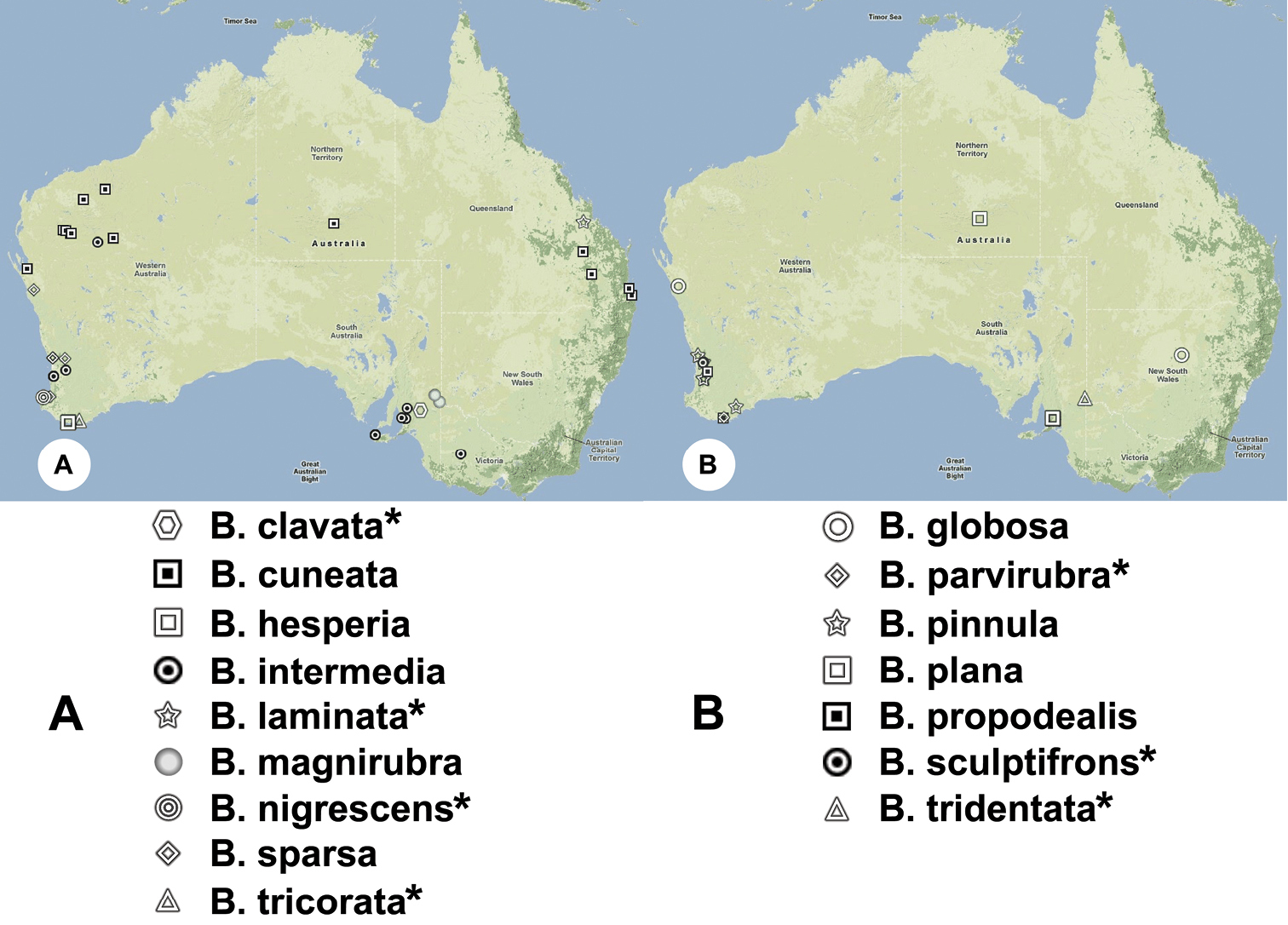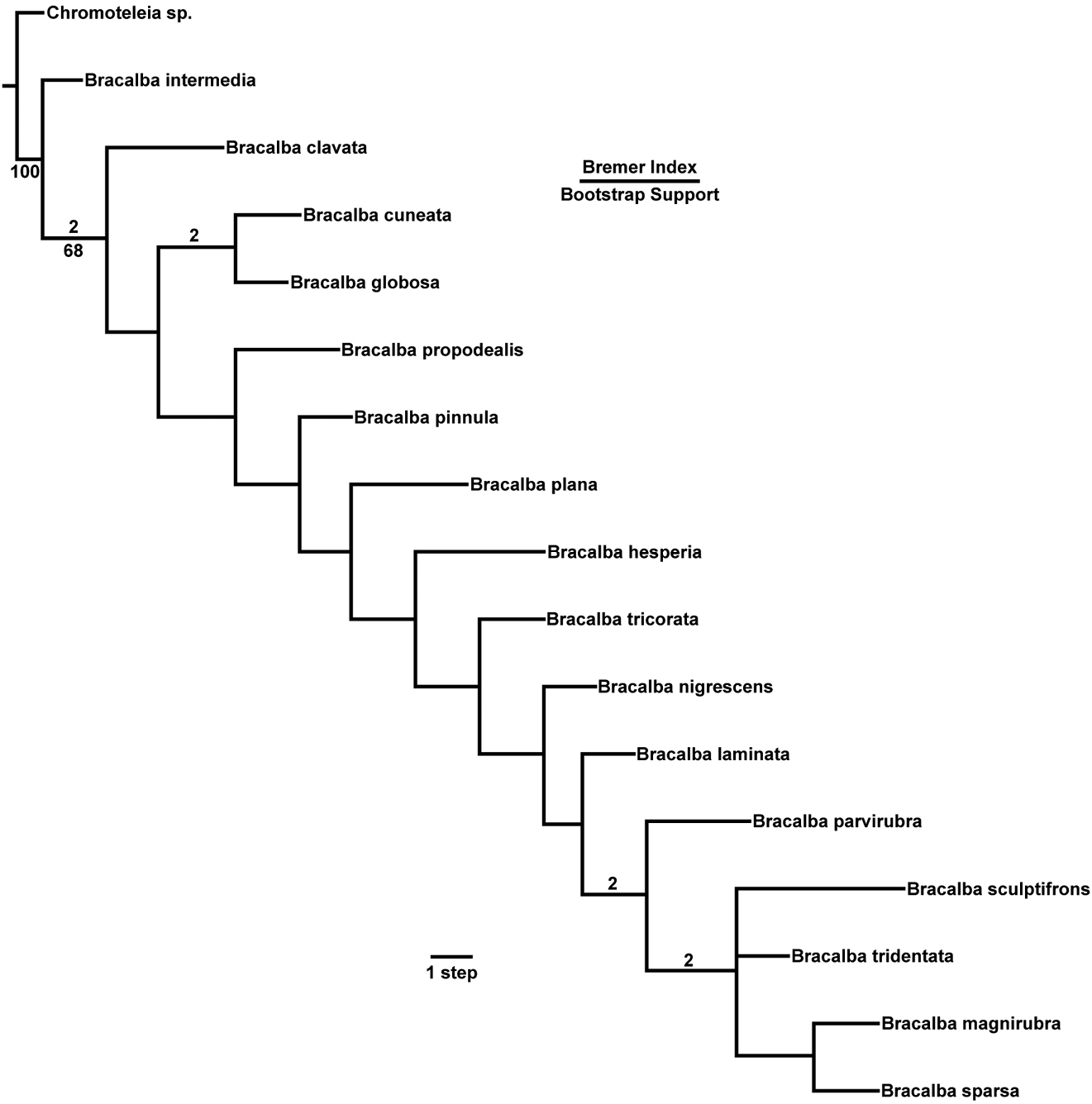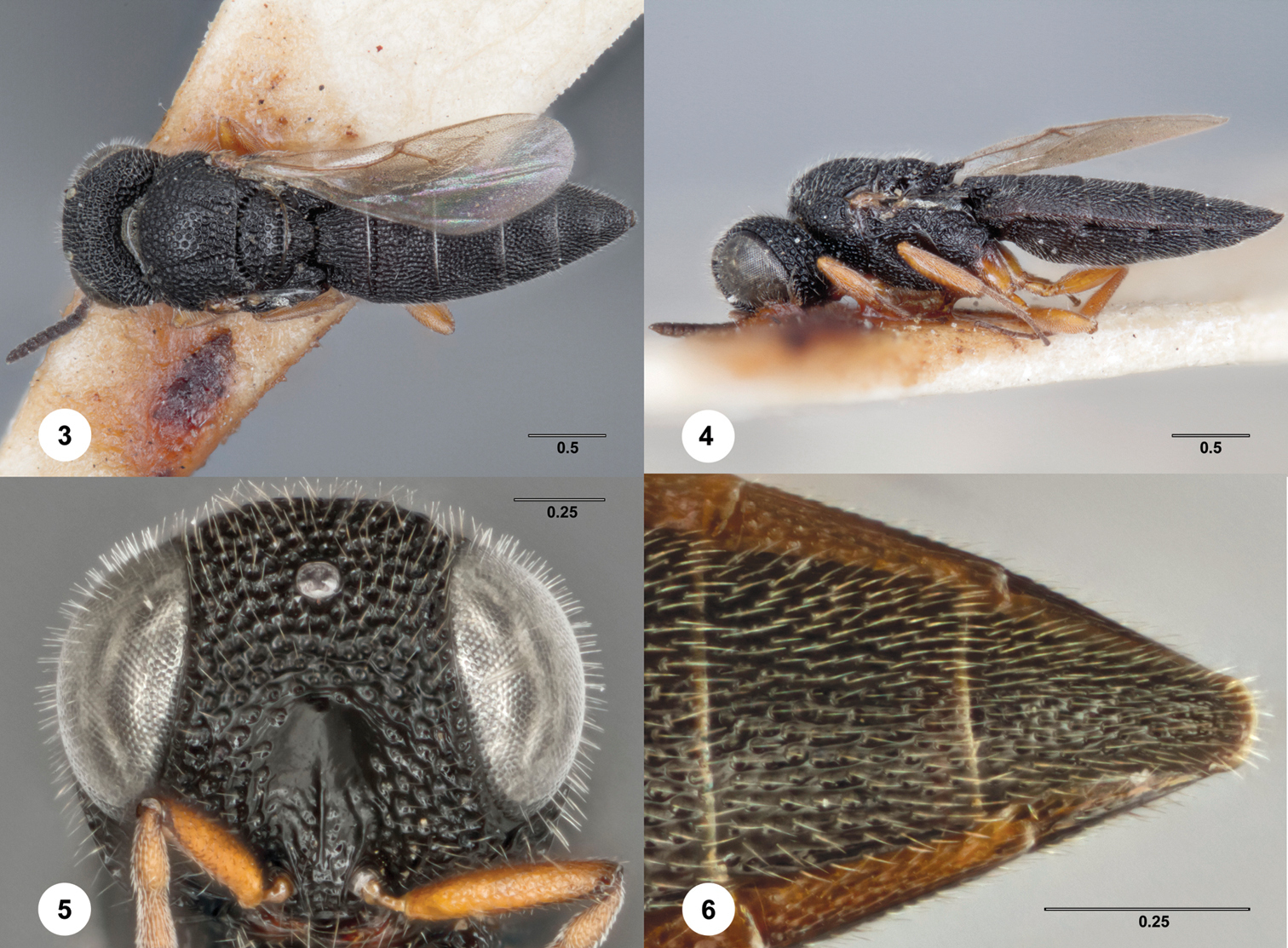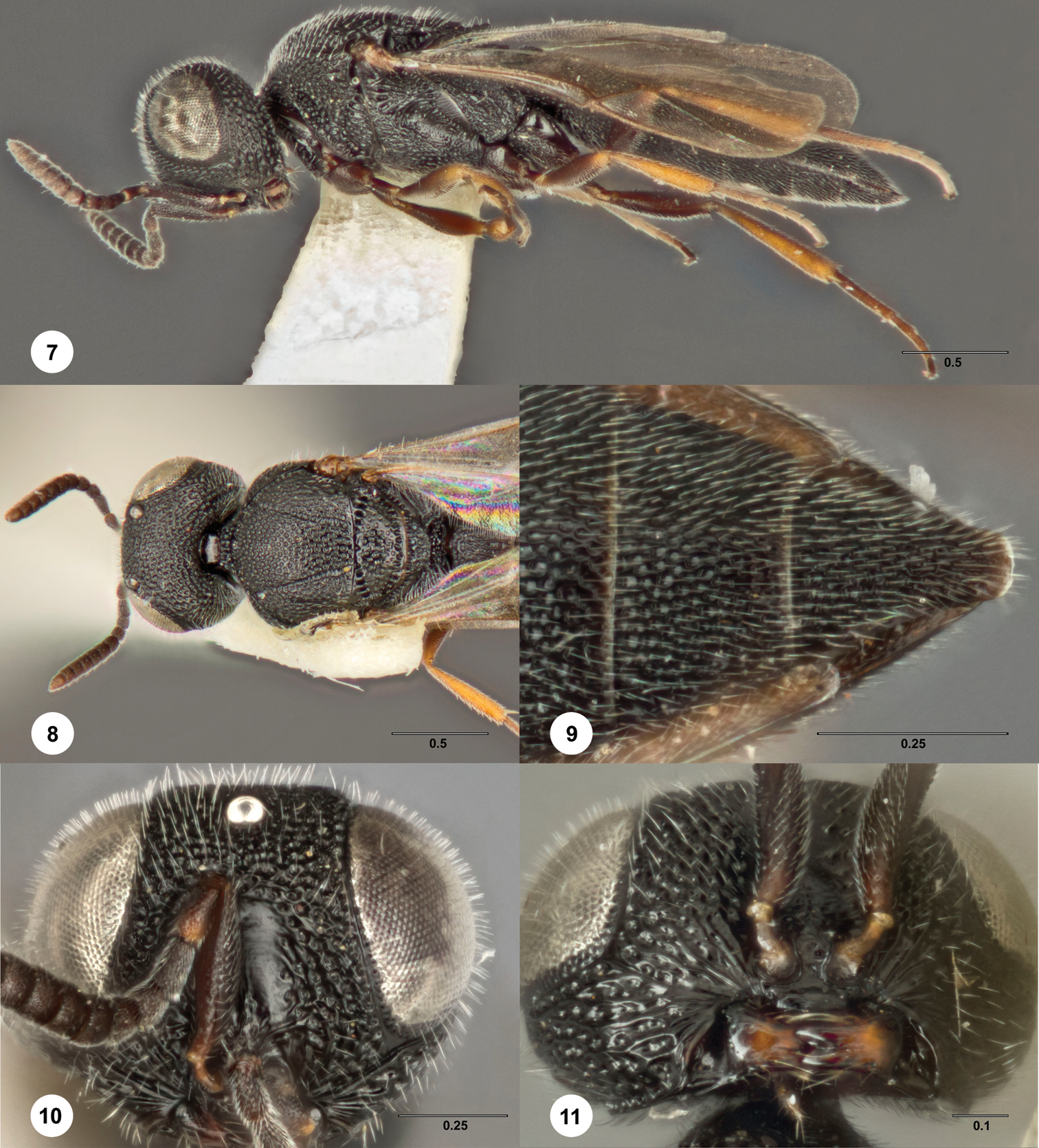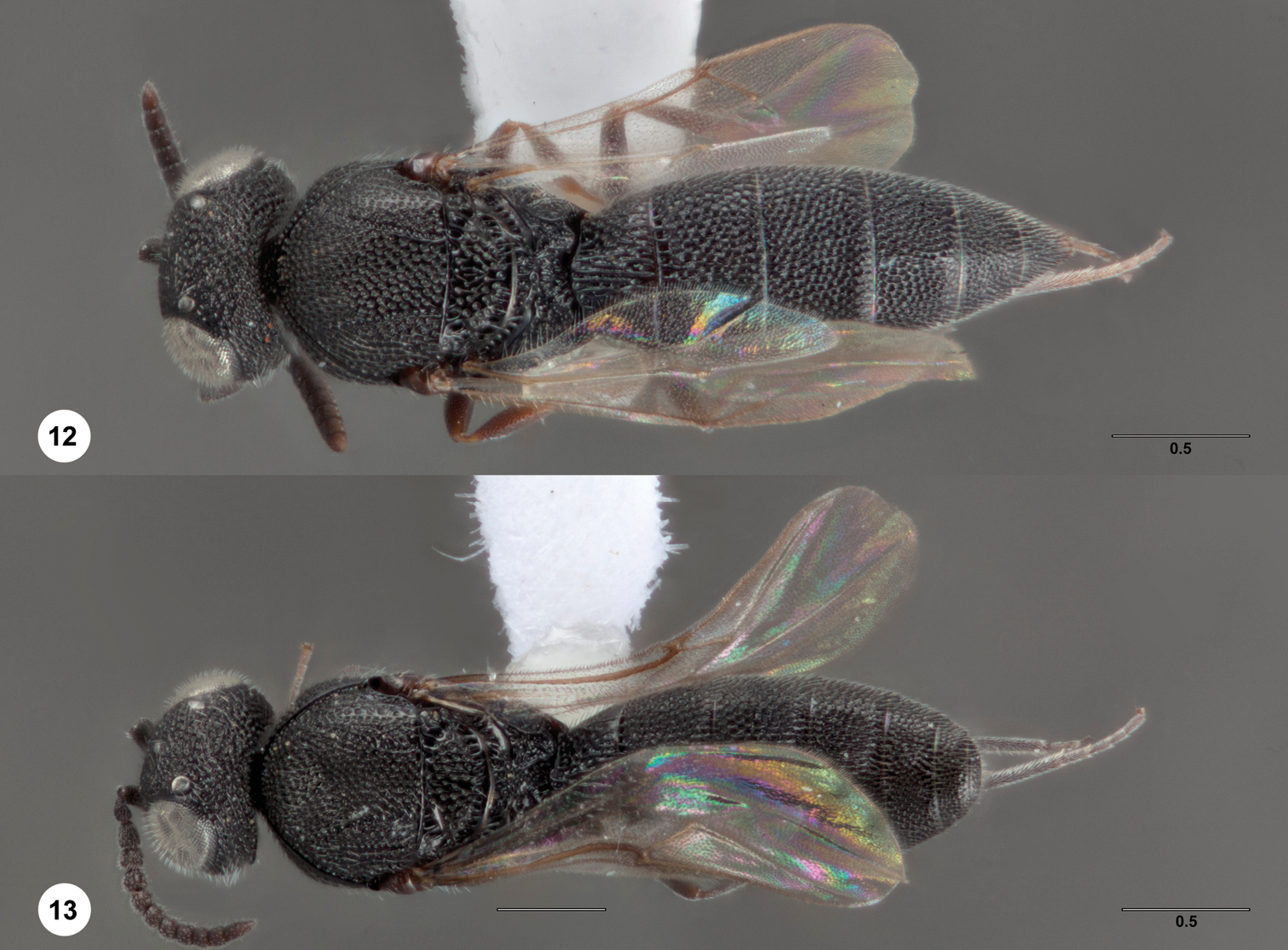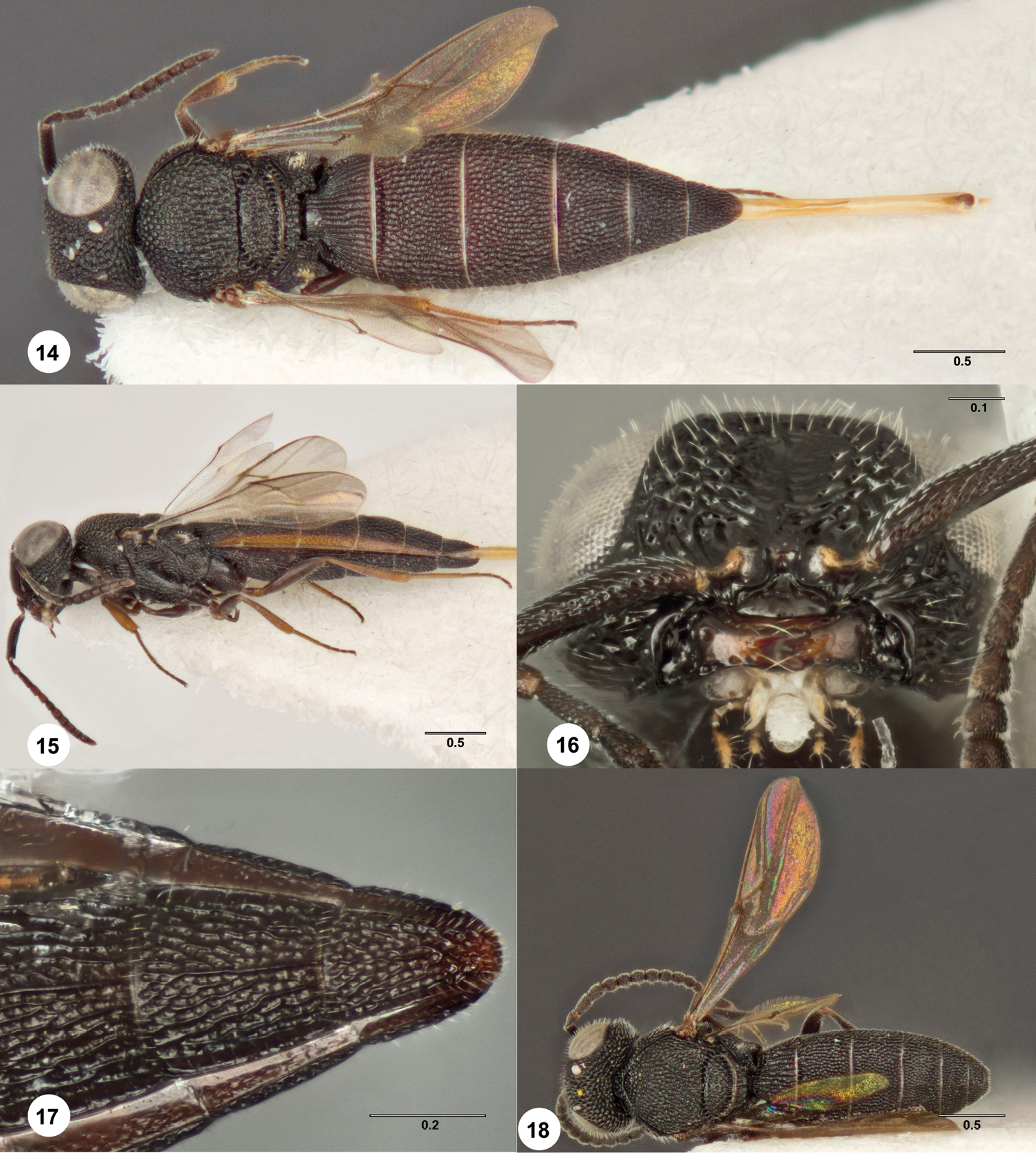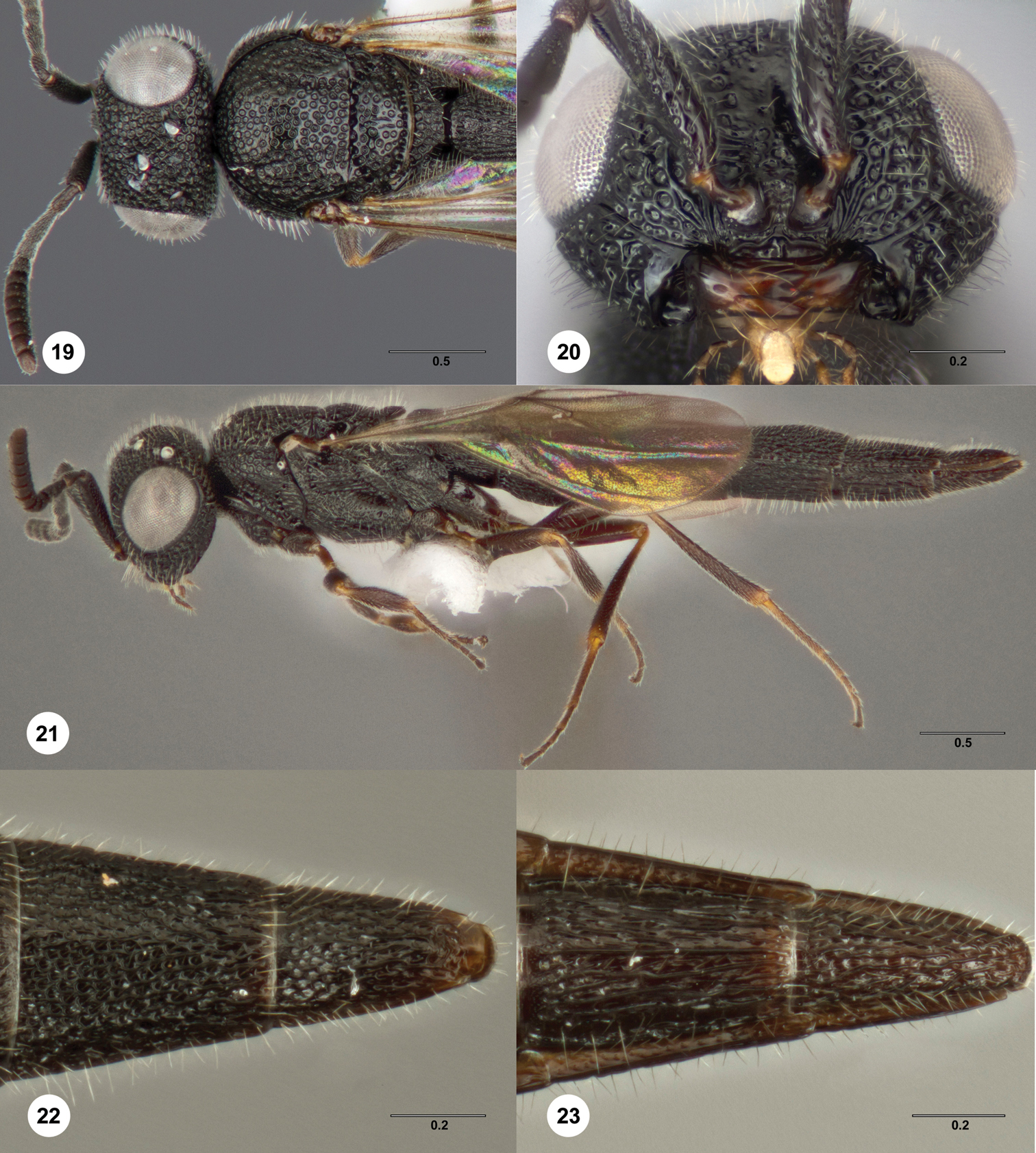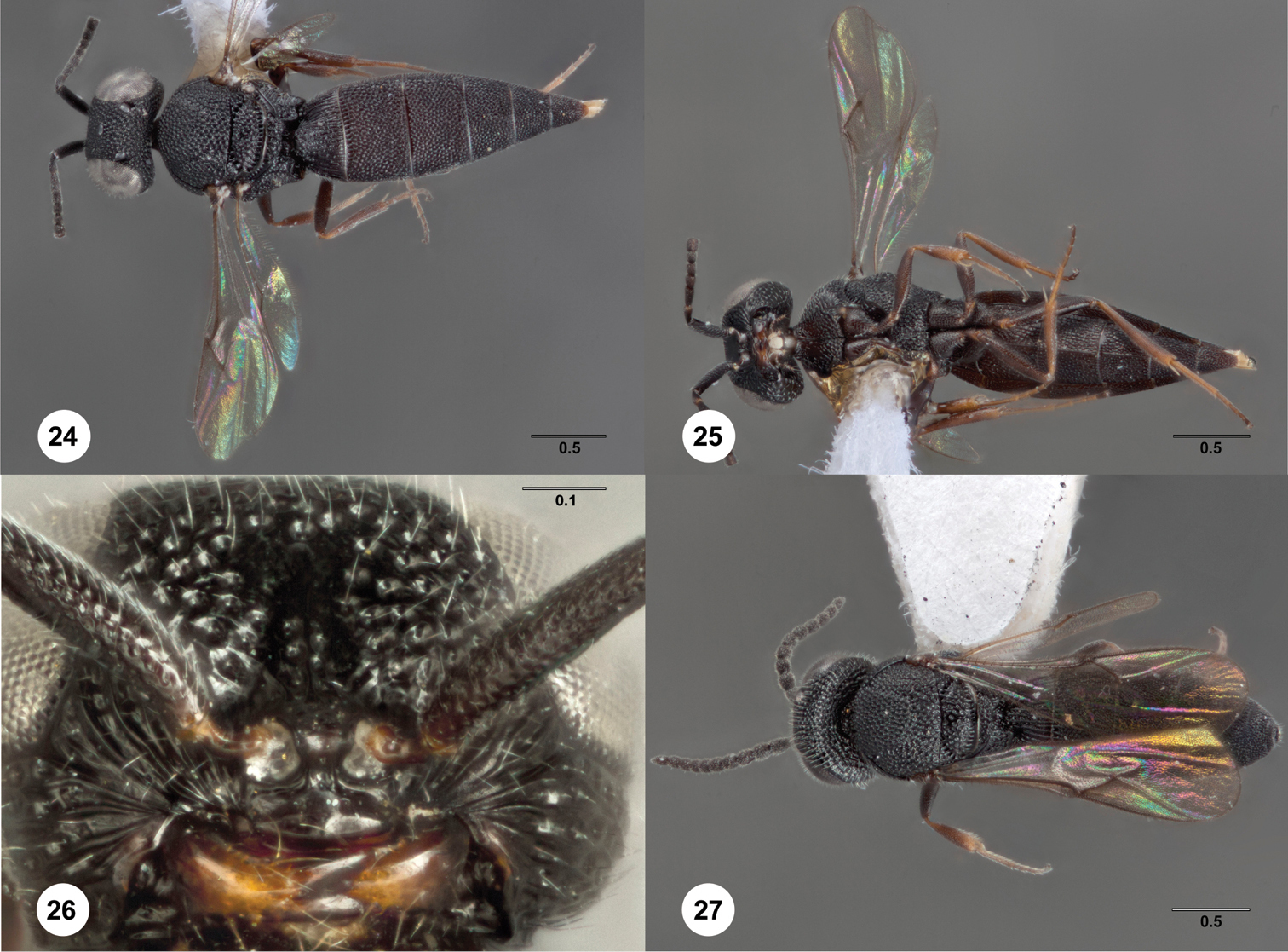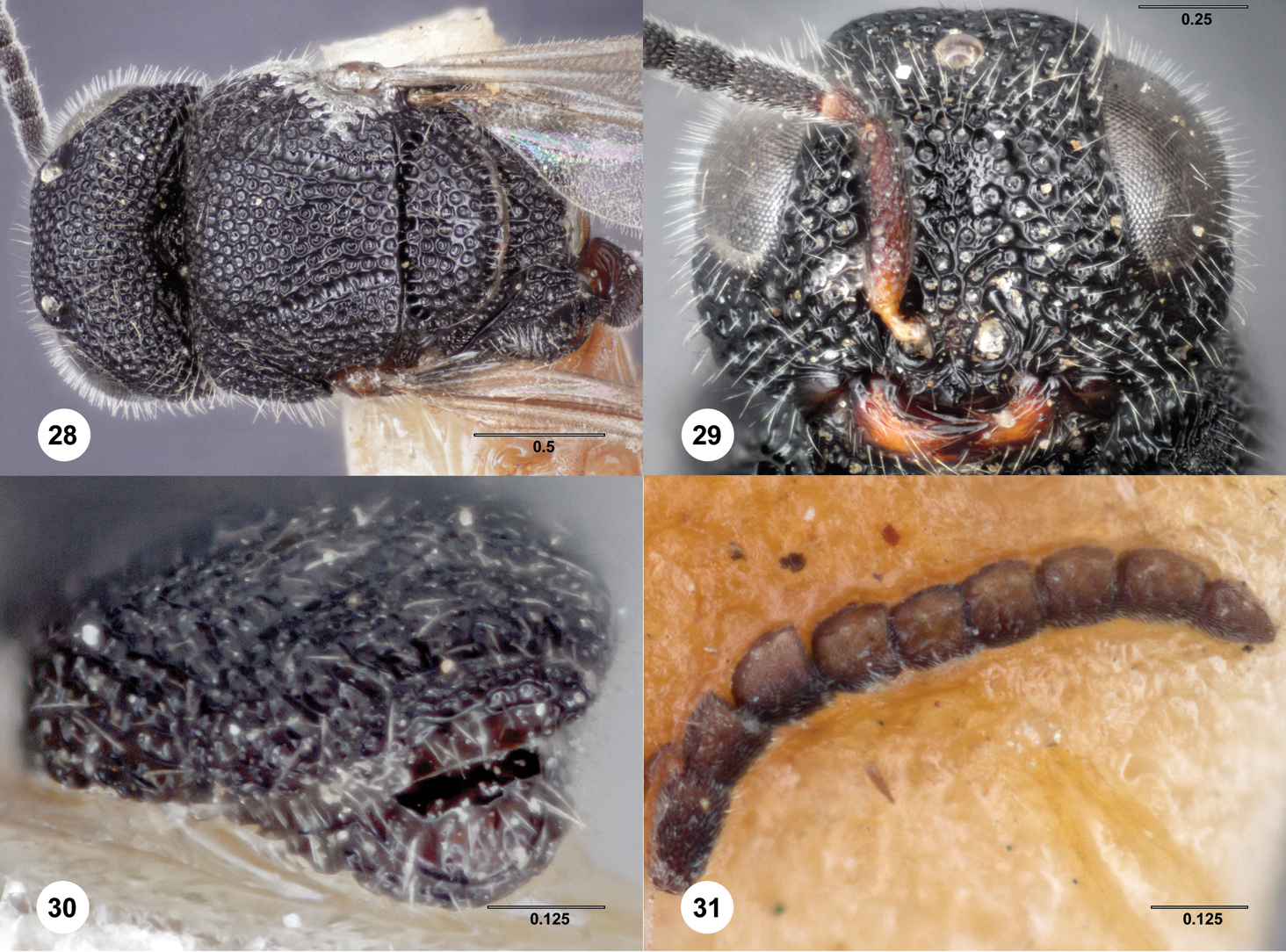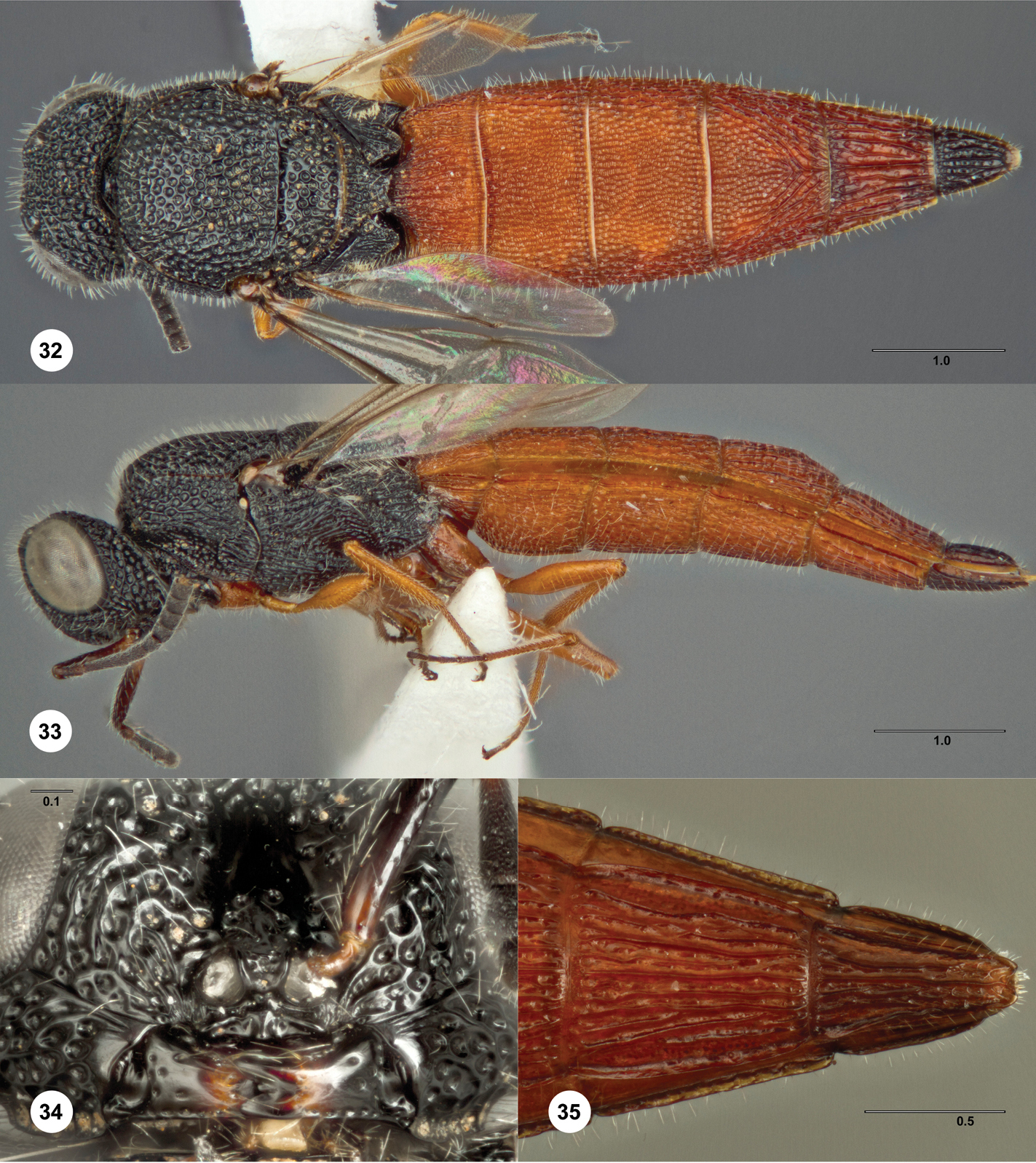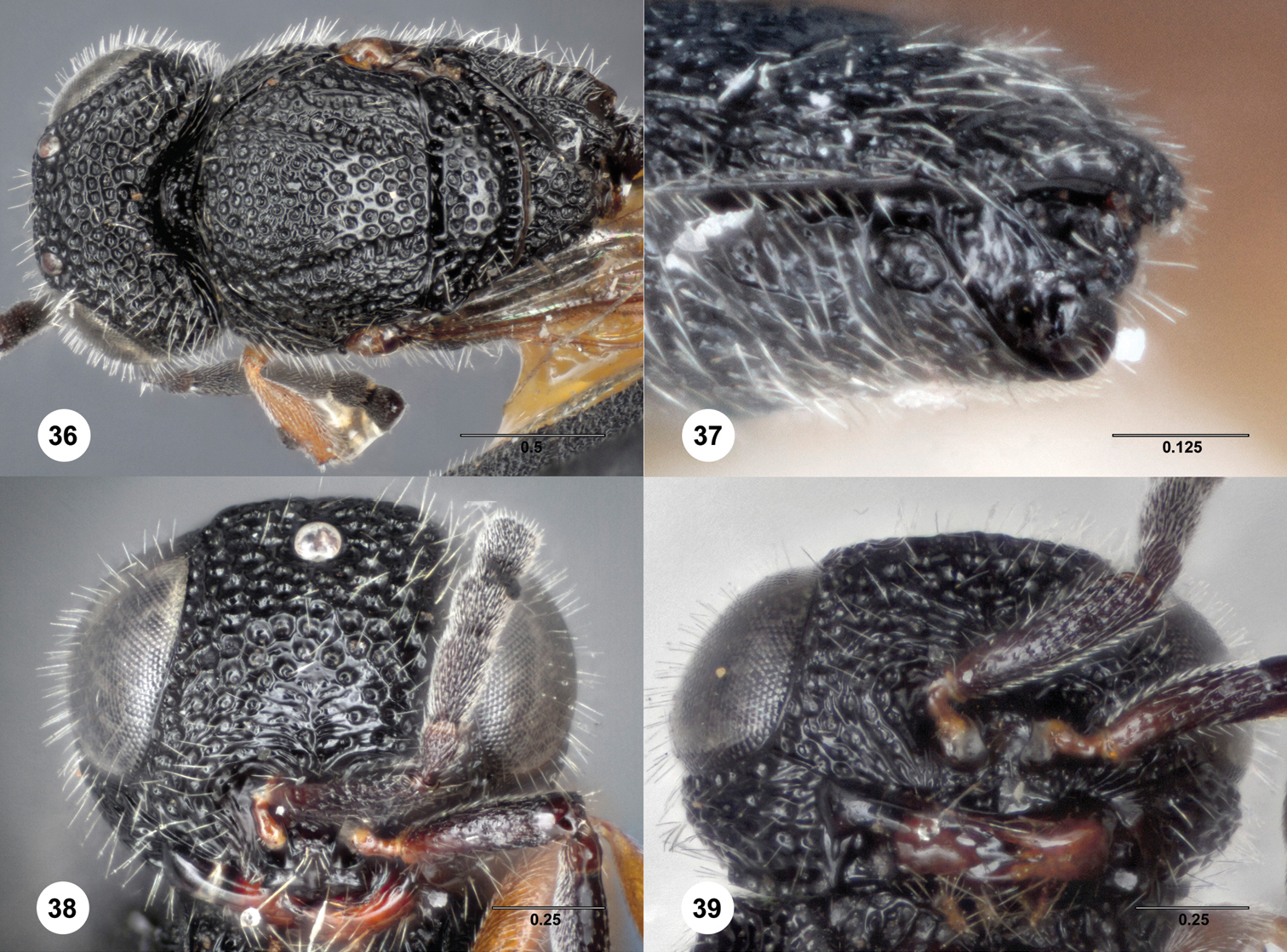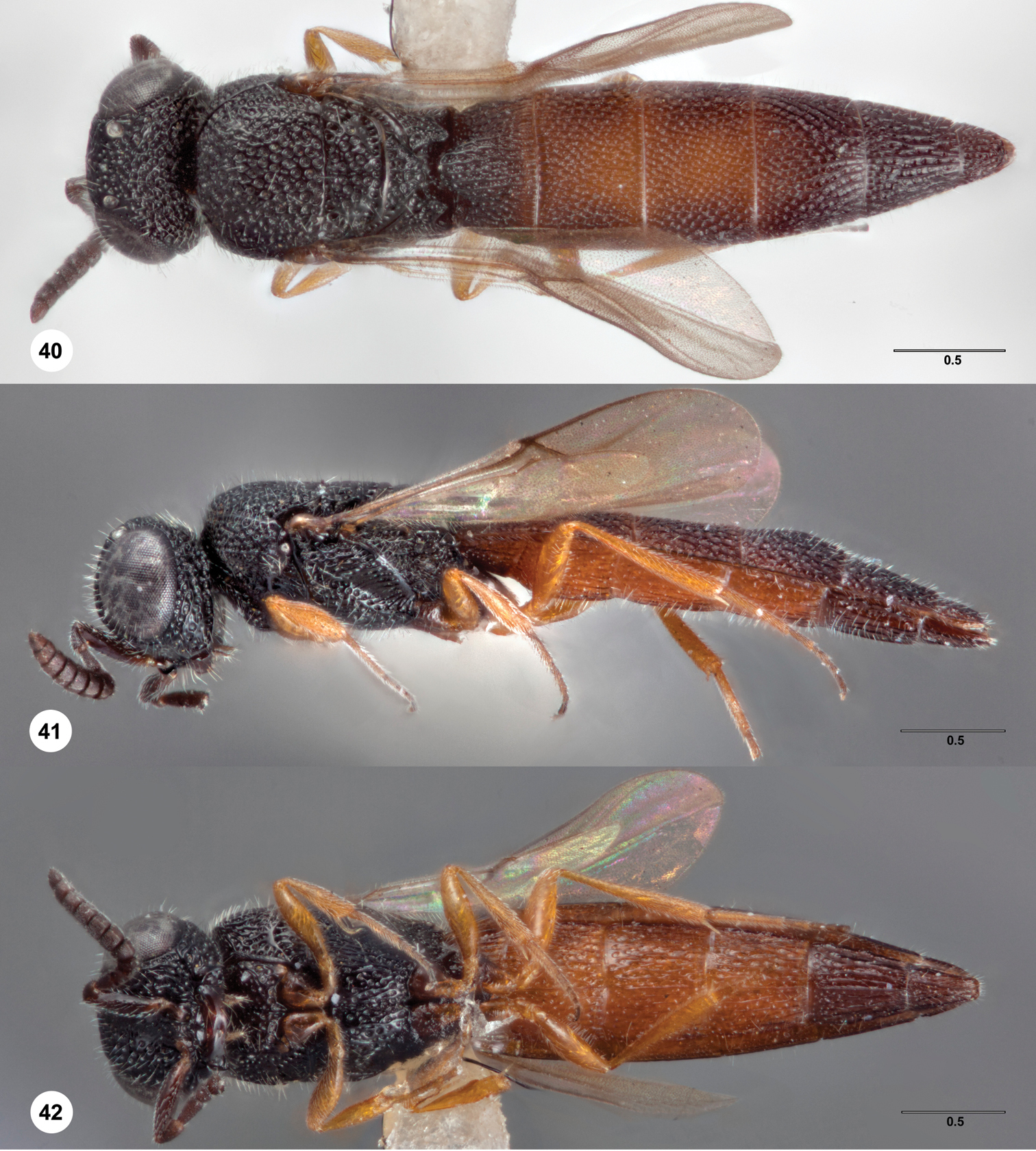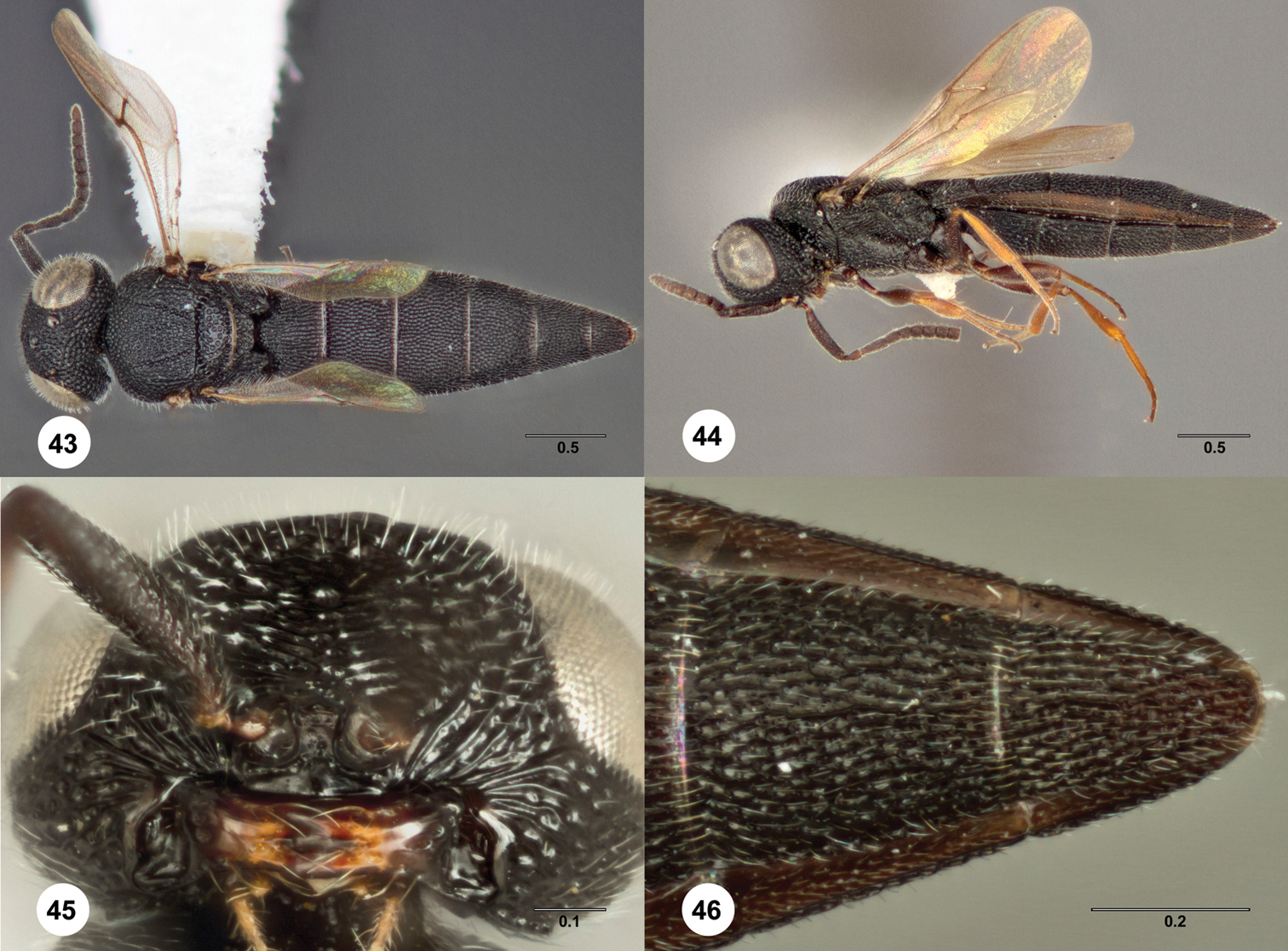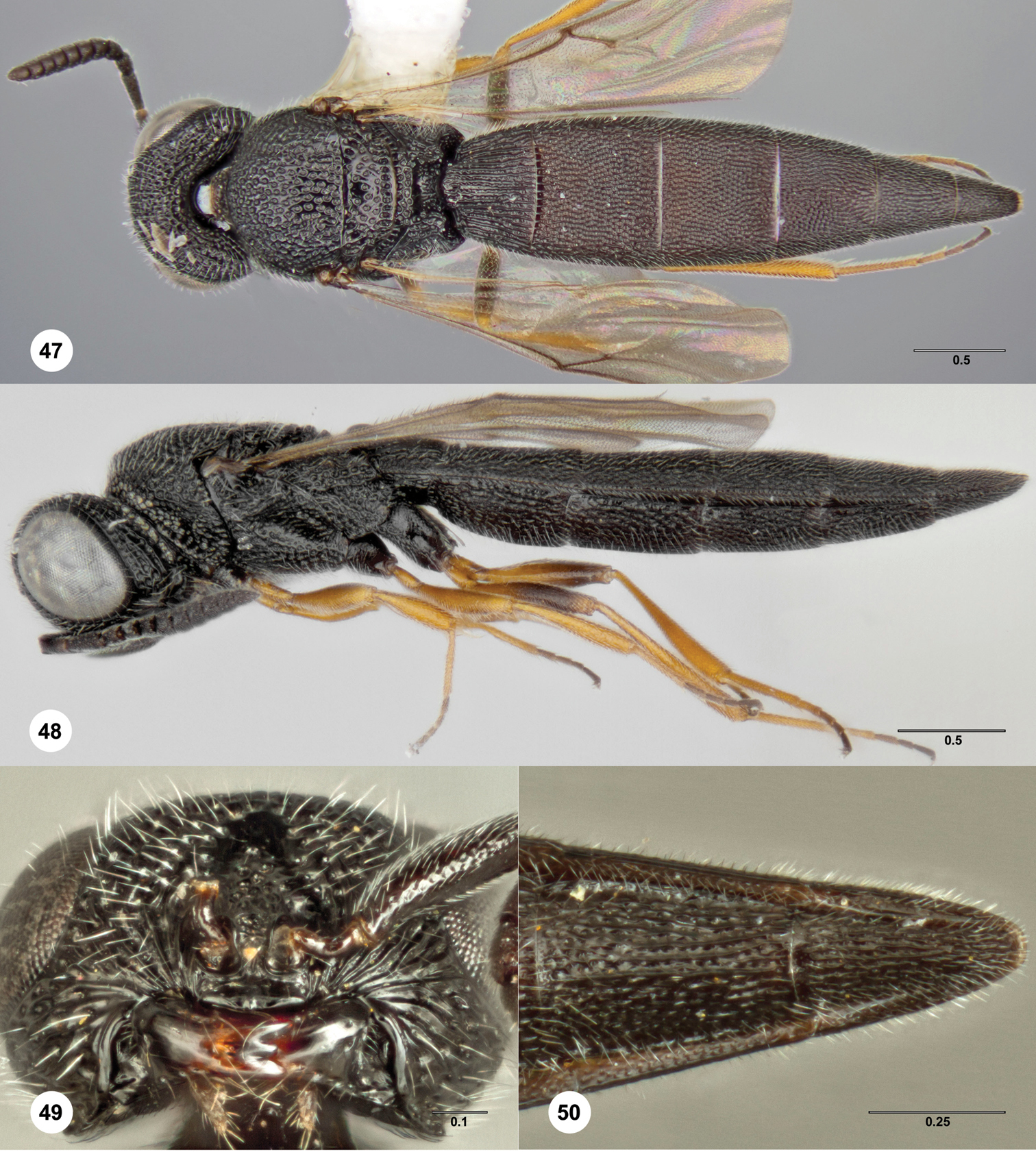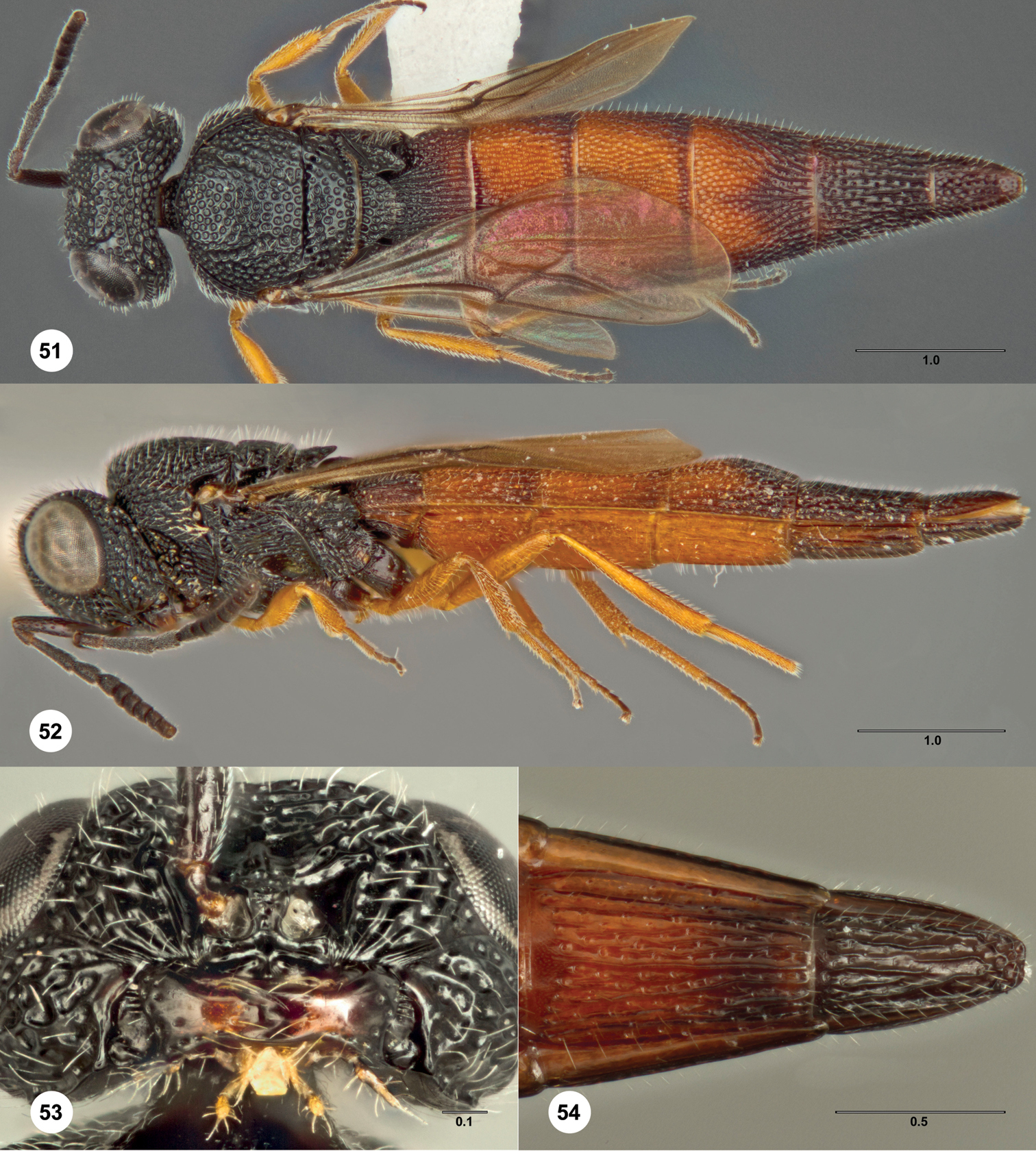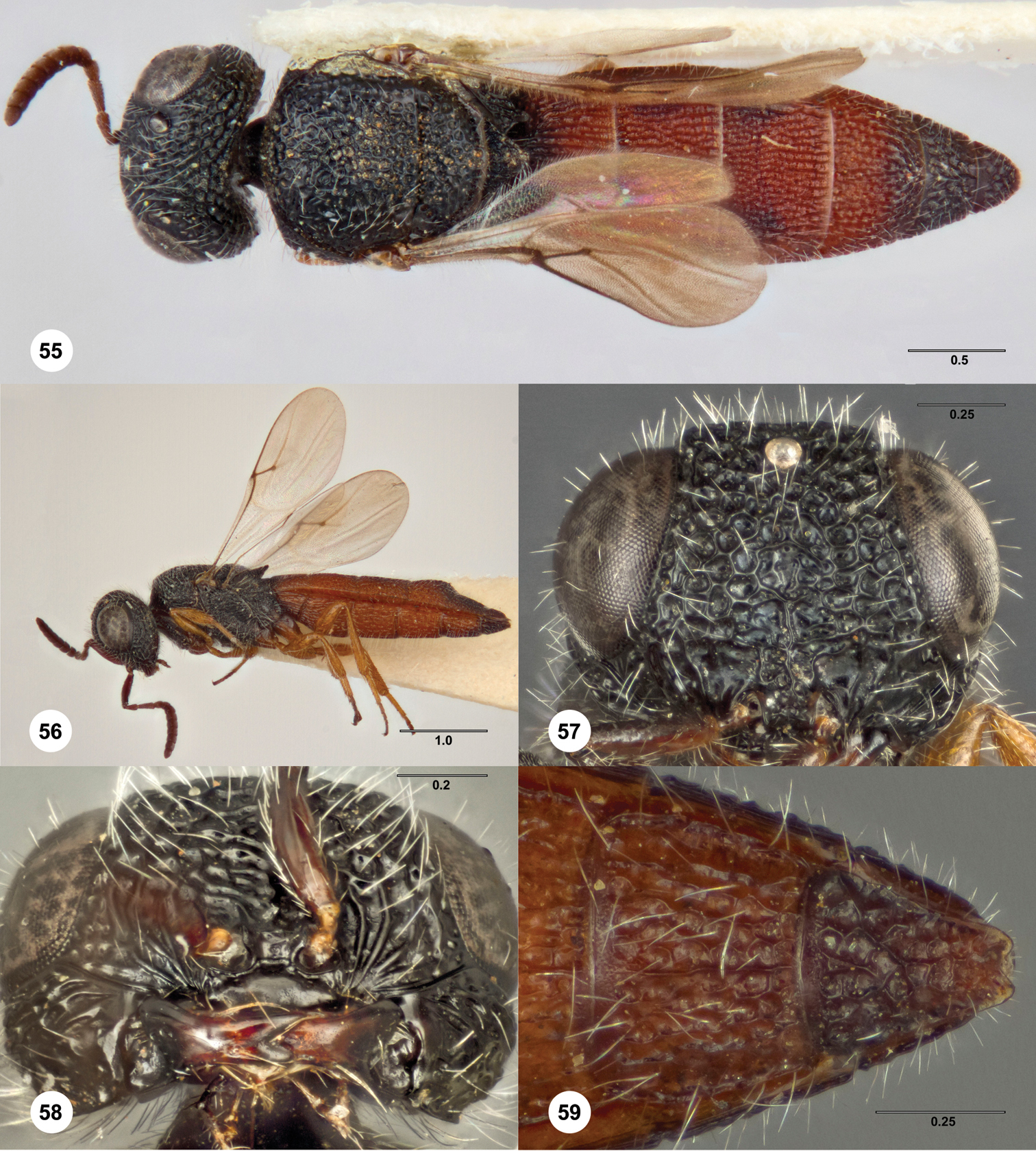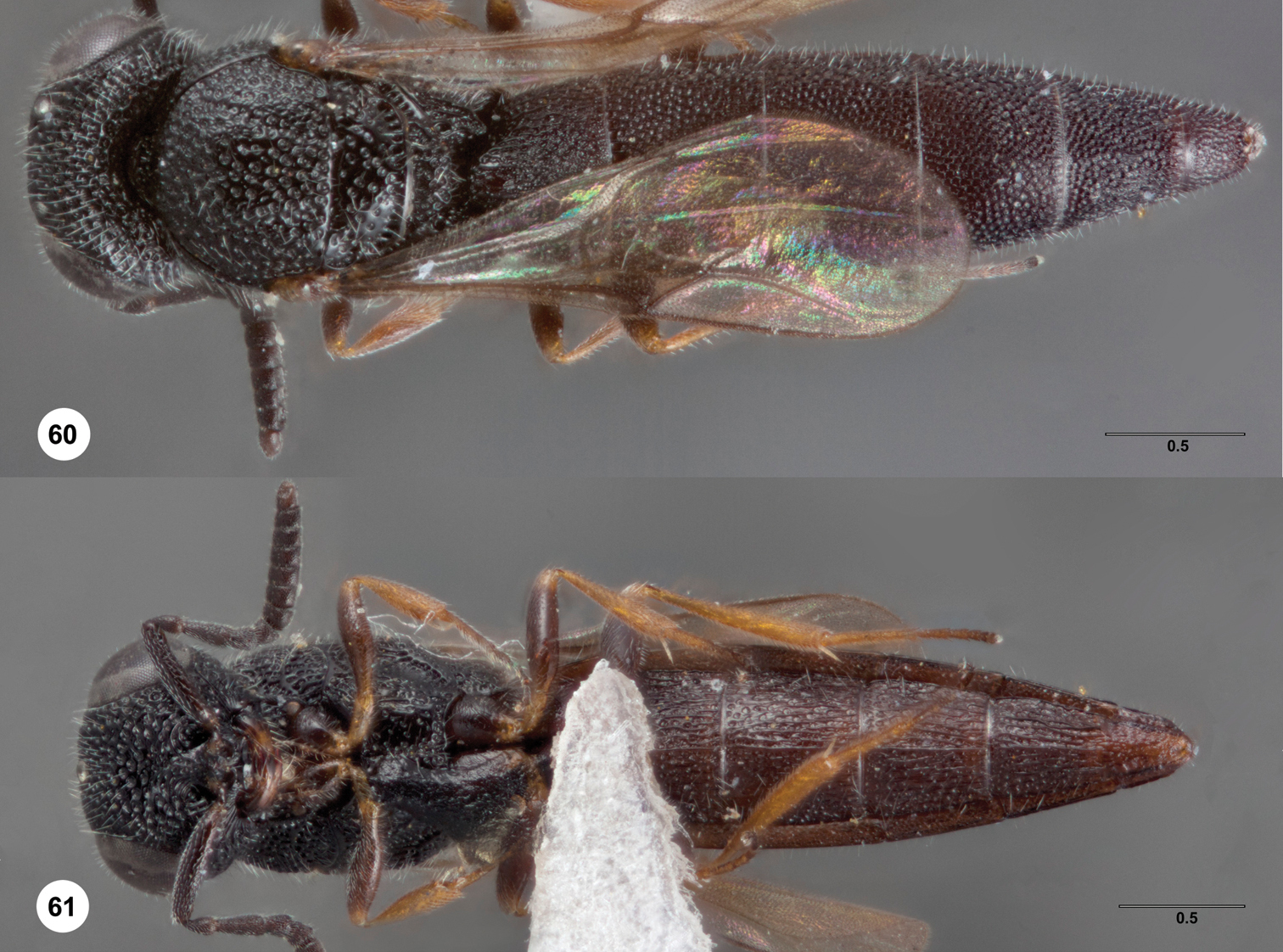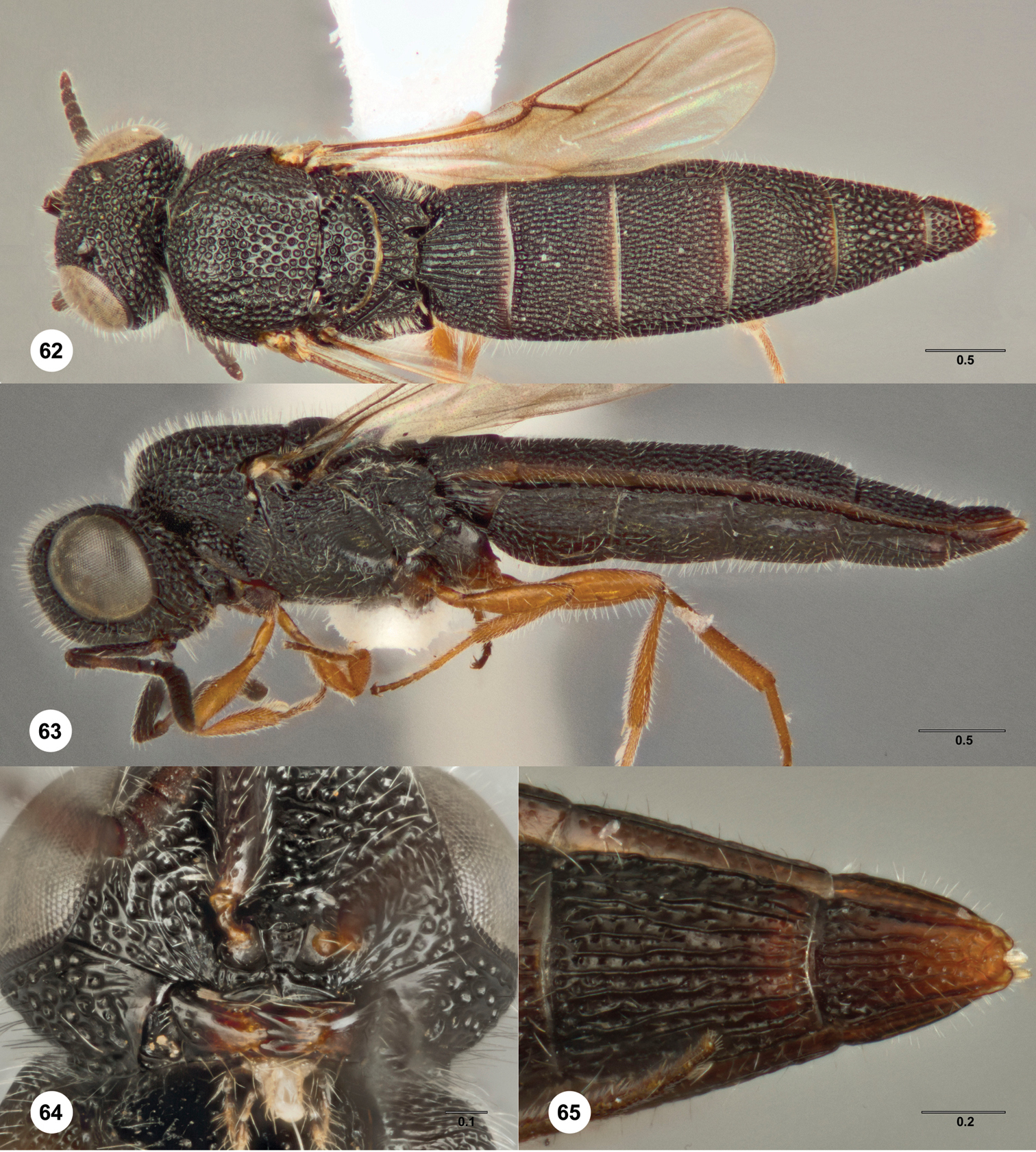






(C) 2012 Roger A. Burks. This is an open access article distributed under the terms of the Creative Commons Attribution License 3.0 (CC-BY), which permits unrestricted use, distribution, and reproduction in any medium, provided the original author and source are credited.
For reference, use of the paginated PDF or printed version of this article is recommended.
The endemic Australian parasitic wasp genus Bracalba (Hymenoptera: Platygastridae) is revised. Sixteen species are recognized: Bracalba cuneata Dodd, Bracalba laminata Dodd and Bracalba nigrescens (Dodd) are redescribed and thirteen new species are recognized; Bracalba clavata Burks, sp. n., Bracalba globosa Burks, sp. n., Bracalba hesperia Burks, sp. n., Bracalba intermedia Burks, sp. n., Bracalba magnirubra Burks, sp. n., Bracalba parvirubra Burks, sp. n., Bracalba pinnula Burks, sp. n., Bracalba plana Burks, sp. n., Bracalba propodealis Burks, sp. n., Bracalba sculptifrons Burks, sp. n., Bracalba sparsa Burks, sp. n., Bracalba tricorata Burks, sp. n., and Bracalba tridentata Burks, sp. n. The genus is found continent-wide but mostly south of the Tropic of Capricorn, and with the highest species diversity occurring in the Pilbara and south-western regions of Western Australia. The hosts of Bracalba are unknown but specimens reared from eggs confirm that the genus is associated with orthopteran hosts. A preliminary phylogeny of species did not indicate that species groups were monophyletic, but they are retained despite paraphyly because they are convenient for specimen identification.
Platygastroidea, Platygastridae s.l., Scelionidae, Bracalba, Scelioninae, key, revision, database, endemism, parasitoid
The Platygastroidea are a highly diverse component of the Australian parasitoid wasp fauna with 666 described species in 80 genera (
The first Australian scelionids were described by
The current study focuses on one of the few genera, Bracalba Dodd, that is endemic to the Australian continent. Among other characters, the genus is recognised by its stout, sculptured body, obviously setose eyes, face with pronounced frontal depression, and very long fore wing postmarginal vein (R1). Previously known from only three species, two from south-eastern Queensland and one from south-western Western Australia, this revision treats 16 species in total. In addition, we document the distribution of all species, present a key to their identification, and undertake a preliminary analysis of species-level relationships.
The contributions of the individual authors are as follows; R.A. Burks: character definition, species concept development; key development, imaging, capture of specimen data, manuscript preparation, phylogenetic analysis and illustration; L. Masner: specimen acquisition, and generic overview; N.F. Johnson: generic concept development and manuscript preparation ; A.D. Austin: initial species concept development, manuscript preparation, and taxonomic overview.
Materials and methodsSpecimens examined were provided by the following collections: The American Entomological Institute, Gainesville, Florida, USA (AEIC)1; Australian Museum, Sydney, Australia (AMSA)2; Australian National Insect Collection, Canberra, Australia (ANIC)3; The Natural History Museum, London, United Kingdom (BMNH)4; Canadian National Collection of Insects, Arachnids and Nematodes, Ottawa, Canada (CNCI)5; Museum of Victoria, Entomology, Melbourne, Australia (MVMA)6; Museum of Comparative Zoology, Harvard University, Cambridge, Massachusetts, USA (MCZC)7; C.A. Triplehorn Insect Collection, Ohio State University, Columbus, Ohio (OSUC)8; Queensland Primary Industries and Fisheries Insect Collection, Indooroopilly, Australia (QDPC)9; Queensland Museum, Brisbane, Australia (QMBA)10; R.M. Bohart Museum, University of California, Davis, USA (UCDC)12; Western Australian Museum, Perth, Australia (WAMP)13; Waite Insect and Nematode Collection, Adelaide, Australia (WINC)14. South Australian and Northern Territory holotypes for species newly described in this manuscript are deposited in the South Australian Museum, Adelaide, Australia (SAMA)11.
This revision is a product of the Platygastroidea Planetary Biodiversity Inventory, funded by the U.S. National Science Foundation (N.F. Johnson, Ohio State University; A.D. Austin, University of Adelaide; Principal Investigators). One objective of this project is to use biodiversity informatics resources to accelerate taxonomic processes, making real-time collaboration possible within a community of researchers. Data associated with specimens examined in this study can be accessed at hol.osu.edu and by entering the unique specimen identifier (e.g. OSUC 238448) in the search form. Morphological terminology follows
Illustration and data citations. Photographs were taken using a Visionary Digital BK+ Imaging System, November 2010 model, with either a K2 Long Distance Microscope or a 65 mm varifocal lens. Source photos were stacked using Zerene Stacker version 1.04 and enhanced using Adobe Photoshop CS5.
Phylogenetic analysis. An exact search using implicit enumeration (branch-and-bound) was performed using TNT (Tree analysis using New Technology) version 1.1 (
urn:lsid:zoobank.org:act:E5095F58-4603-4796-9D22-03A759B7B29
urn:lsid:biosci.ohio-state.edu:osuc_concepts:457
http://species-id.net/wiki/Bracalba
Eye setose; frontal depression present; antenna 12-segmented; netrion present; postmarginal vein of fore wing present, longer than marginal and stigmal veins; mesotibia and metatibia each with 1 spur; metascutellum setose dorsally and ventrally; ovipositor Scelio-type.
Body length: 2.75–6.88 mm (n=78).
Head. Head shape in dorsal view: transverse. Hyperoccipital carina: absent. Occipital carina: present laterally, broadly interrupted medially; present, complete medially. Occipital carina sculpture: crenulate. OOL: lateral ocellus nearly contiguous with inner orbits, OOL < 0.5 OD. Upper frons: convex, without frontal shelf. Scrobe shape: frons with shallow unmargined depression above antennal foramina. Frons sculpture: areolate rugose, transversely striate within scrobe; areolate rugose, scrobe sparsely punctate. Submedian carina: absent. Orbital carina: absent. Inner orbits: diverging ventrally. IOS/EH: IOS slightly less than EH. Interantennal process: triangular in lateral view, well-developed. Central keel: absent. Antennal foramen opening: nearly anteriorly. Lower frons striae: absent. Malar sulcus: present. Compound eye size: of normal proportions, not significantly reduced. Compound eye setation: densely setose; sparsely setose. Gena: narrow, weakly convex, receding behind posterior orbit. Clypeus shape: transversely rectangular. Apical margin of clypeus: rounded; with a small median point. Anteclypeus: absent. Postclypeus: absent. Labrum: not visible. Mandible shape: moderate. Mandibular teeth: apex with 2, acute, subequal teeth; apex tridentate, teeth acute, middle tooth distinctly shortest. Arrangement of mandibular teeth: transverse. Number of maxillary palpomeres: 4. Shape of maxillary palpomeres: cylindrical. Number of labial palpomeres: 2.
Antenna. Number of antennomeres in female: 12. Number of antennomeres in male: 12. Insertion of radicle into A1: parallel to longitudinal axis of A1. Shape of A1: more or less cylindrical, not flattened. Length of A3 of female: distinctly longer than A2. Number of clavomeres in female antenna: 8. Claval formula of female antenna: A12-A7/1-2-2-2-2-2; A12-A6/1-2-2-2-2-2-2; A12-A6/1-2-2-2-2-2-1. Arrangement of doubled multiporous plate sensilla on female clava: in longitudinal pairs. Tyloid distribution on male antenna: A5 only. Shape of male flagellum: filiform.
Mesosoma. Mesosoma shape in dorsal view: longer than wide. Mesosoma shape in lateral view: longer than high. Medial portion of transverse pronotal carina: absent. Posterior apex of pronotum in dorsal view: straight, bifid apically to articulate with tegula. Vertical epomial carina: absent. Dorsal epomial carina (lateral portion of transverse pronotal carina of
Legs. Number of mid tibial spurs: 1. Number of hind tibial spurs: 1. Dorsal surface of hind coxa: smooth. Hind tibia shape: cylindrical, ecarinate. Trochantellus: indicated by transverse sulcus on femur.
Wings. Wing development of female: macropterous. Wing development of male: macropterous. Tubular veins in fore wing: present. Bulla of fore wing R: absent. Extent of marginal venation of fore wing: distinct marginal or postmarginal veins developed. Origin of r-rs in fore wing: arising at junction of R/R1 with costal margin. Development of basal vein (Rs+M) in fore wing: nebulous, weakly pigmented. Development of R in hind wing: elongate, extending to costal margin.
Metasoma. Number of external terga in female: 6. Number of external sterna in female: 6. Number of external terga in male: 8. Number of external sterna in male: 7. Shape of metasoma: acuminate, widest submedially. Laterotergites: present, narrow. Laterosternites: present. T1 of female: raised medially into low, rectangular or subelliptical platform, laterally depressed. Relative size of metasomal terga: T2–T4 largest, subequal in size. Terga with basal crenulae: T1–T4. Sublateral carinae on terga: absent. Median longitudinal carina on metasomal terga: absent; present. Distribution of felt fields: absent. Ovipositor type: Scelio-type (
Dodd did not specify the source of the name for this genus, but presumably it is derived the name of the Queensland town of Bracalba. (Dodd also used the names of Merriwa, NSW and Nyleta, QLD for other genera.) He originally combined this name with two species epithets of variable gender, both coined in feminine form: Bracalba cuneata and Bracalba laminata, clearly indicating that he intended Bracalba to be a feminine noun.
Bracalba has been collected only from Australia (Fig. 1), and has seldom been collected north of the Tropic of Capricorn. The furthest north that any Bracalba has been collected was at 24°39'S, and only two species have been found north of Alice Springs, NT. Location records show that the highest species diversity occurs in the Pilbara and south-western regions of Western Australia.
Collection events for each Bracalba species. * = species known from only one locality.
The hosts of Bracalba are unknown but the structure of the ovipositor (Scelio-type;
The implicit enumeration search found two optimum trees of 166 steps (strict consensus: Fig. 2). Bracalba was monophyletic with respect to the Chromoteleia outgroup (bootstrap = 100). Intuitively-based species groups were not monophyletic in the analysis, but this was likely due to homoplasy resulting from inclusion of many sculptural and coloration characters that have mainly descriptive value. Species with a bend at metasomal segment 4 in females did not form a monophyletic group, but this was complicated by the smooth transition in this character from being distinctively present to clearly absent. One feature that was helpful in determining species group, but which was not reported in the key because it was too difficult to accurately and consistently assess, was the lateral margin of the dorsal axillar area. In the cuneata-group, the dorsal axillar area was essentially triangular, broadening posteriorly, with the lateral margin sometimes forming a posterior tooth. In the laminata-group the dorsal axillar area was generally more nearly semicircular, broadest at midlength, and with the lateral margin not forming a posterior tooth. Apparent variation, and difficultly in observing this character with confidence, caused us to omit it from the key.
Strict consensus phylogram of two most parsimonious trees for species of Bracalba using implicit enumeration (branch-and-bound exact search), score = 166. Bootstrap support values found using TNT new technology search (set initial level = 95). Bremer support values above 1, and bootstrap values about 50% indicated on branches.
Note: It is imperative to consult figures when using the below key, as shape features of the metascutellum and metasoma are very important in identifying Bracalba species with any hope of accuracy.
| 1 | Mandibles bidentate with no hint of a third tooth (Fig. 11), teeth narrowly separated and of nearly the same length. Females: T4 without bend or hump (Figs 4, 7); fore wings extending to middle of T5 or beyond when folded over body | 2 (cuneata-group) |
| – | Mandibles either tridentate with a small middle tooth (Fig. 40) or very rarely bidentate, but with teeth broadly separated and/or dorsal tooth much longer than ventral tooth (Figs 52, 58). Females: T4 with or without bend or hump (bend: Fig. 33, hump: Fig. 56); fore wings extending only to middle or apex of T4 when folded over body | 4 (laminata-group) |
| 2 | Metascutellum flat (Figs 12–13), not projecting dorsally. Male: A3 short: 1.1–1.2× as long as broad (Fig. 13) | Bracalba plana Burks, sp. n. |
| – | Metascutellum projecting dorsally (Figs 4, 7). Male: A3 over 1.5× as long as broad | 3 |
| 3 | Mesoscutellum sparsely foveolate, with smooth interspaces (Fig. 8). Mesoscutum smoothly and regularly convex anteriorly and posteriorly (Figs 7–8) | Bracalba globosa Burks, sp. n. |
| – | Mesoscutellum densely foveolate, interspaces with irregular longitudinal rugae (Fig. 3). Mesoscutum abruptly convex only anteriorly, flattened or irregularly convex posteriorly (Figs 3–4) | Bracalba cuneata Dodd |
| 4 | Propodeum with sharp protrusions (from lateral propodeal area) protruding dorsally immediately posterior to metascutellum, reaching at least the same height as the dorsal surface of metascutellum (Figs 47–48). Males unknown | Bracalba propodealis Burks, sp. n. |
| – | Propodeum without such protrusions | 5 |
| 5 | Metascutellum strongly narrowed apically (Figs 28, 32, 36, 40, 55), tapering to an incised or narrowly truncate apex that is narrower than the maximum metascutellar length; metasomal bend or hump present in females (Figs 33, 56) | 6 |
| – | Metascutellum with apex broadly truncate, as broad or broader than total metascutellar length (Figs 14, 19, 24, 43, 47, 60); metasomal bend present or absent in females | 10 |
| 6 | Mesosoma truncate anteriorly (Figs 28, 32), with antero-lateral pronotal corners protruding anteriorly. Metascutellum incised apically | 7 |
| – | Mesosoma smoothly rounded anteriorly (Fig. 36), with antero-lateral pronotal corners much weaker, more rounded, and not protruding anteriorly. Metascutellar apex variable | 8 |
| 7 | Mesoscutellum without median carina (Fig. 32). Females with a mostly reddish metasoma and very large body (at least 6.5 mm long) | Bracalba magnirubra Burks, sp. n. |
| – | Mesoscutellum with median carina (Fig. 28). Color of metasoma in females unknown. Female body length 4.25 mm [using |
Bracalba laminata Dodd |
| 8 | Antennal scrobes crossed by transverse carinae that meet at torular triangle (Fig. 38). Females unknown | Bracalba nigrescens (Dodd) |
| – | Antennal scrobes foveolate or smooth. Females with hump near midlength T4 (Figs 41, 56) | 9 |
| 9 | Antennal scrobes smooth and distinct. Clypeus with blunt median carina (Fig. 42). Female: S6 without apical incision (Fig. 42); T5, S5 with many strong longitudinal carinae (Figs 40, 42) | Bracalba parvirubra Burks, sp. n. |
| – | Antennal scrobes foveolate and indistinct (Fig. 57). Clypeus without median carina (Fig. 58). Female: S6 with strong apical incision (Fig. 59); T5, S5 with at most a median carina (Figs 55, 59) | Bracalba sparsa Burks, sp. n. |
| 10 | Frontal depression with strong longitudinal carina that is crossed by a strong transverse carina dorsally. Clypeus with median carina and transverse dorsal carina (Fig. 53). Metascutellum broadly trapezoidal (Fig. 51). Females: metasoma reddish, T5 and S5 with many longitudinal carinae, S6 without apical notch (Fig. 54) | Bracalba sculptifrons Burks, sp. n. |
| – | Frontal depression without such a set of carinae. Clypeus with weaker or no carinae (Figs 20, 45, 64). Metascutellum variable (Figs 19, 62). Females: metasoma brown to black, T5, S5, and S6 variable | 11 |
| 11 | Metascutellum elongate-trapezoidal with concave lateral margins (Fig. 62). Female: S6 with strong apical notch (Fig. 65); T5, S5 with distinct longitudinal carinae (Figs 62, 65). Males unknown | Bracalba tridentata Burks, sp. n. |
| – | Metascutellum broadly trapezoidal with straight lateral margins (Figs 19, 43, 60), or subrectangular to weakly convex with irregular lateral margins (Figs 14, 24). Female: S6 without apical notch (Figs 17, 23, 46); T5, S5 variable | 12 |
| 12 | Mesoscutellum with a set of incomplete median longitudinal grooves (Fig. 19). Middle mandibular tooth almost as long as the other two (Fig. 20). Clypeus with weak median carina. Female: S5 with longitudinal carinae (Fig. 23). Males unknown | Bracalba hesperia Burks , sp. n. |
| – | Mesoscutellum without median grooves (Fig. 43). Middle mandibular tooth tiny, much smaller than the other two (Figs 16, 26, 45). Clypeus without median carina. Female: S5 with or without carinae | 13 |
| 13 | Mesoscutellum sparsely foveolate, with broad interspaces (Fig. 60). Female: S5 with longitudinal carinae (Fig. 61) | Bracalba tricorata Burks, sp. n. |
| – | Mesoscutellum densely foveolate (interspaces very narrow) except sometimes a small smooth antero-median area (Figs 14, 24, 43). Female: S5 finely foveolate, without longitudinal carinae (Figs 17, 46) | 14 |
| 14 | Metascutellum trapezoidal in dorsal view, with straight lateral margins (Fig. 43). Female: Antenna with seven apical segments bearing large ventral sensilla, forming a more or less distinct 7-segmented club that includes A6 | Bracalba pinnula Burks, sp. n. |
| – | Metascutellum in dorsal view irregularly subrectangular or cushion-like, with irregular margins (Figs 14, 24). Female: Antenna with large ventral sensilla on only the six apical segments, these expanded into a 6-segmented club that is distinct from A6 (Figs 14–15) | 15 |
| 15 | Mesoscutellum with fine wrinkles or carinae in interspaces between foveolae (Fig. 14). Female: T6 broader than long (Fig. 14) | Bracalba clavata Burks, sp. n. |
| – | Mesoscutellum with smooth interspaces between foveolae (Fig. 24); occasionally smaller foveolae may be present in the interspaces, or the interspaces themselves could be raised to form large wrinkles. Female: T6 longer than broad (Fig. 24) | Bracalba intermedia Burks, sp. n. |
urn:lsid:zoobank.org:act:10EC007E-A303-4847-BDD9-29AF68935211
urn:lsid:biosci.ohio-state.edu:osuc_concepts:4126
http://species-id.net/wiki/Bracalba_cuneata
Figures 3–6; Morphbank 15Female. Body length 3.25–4.00 mm (n=29). Color of antenna beyond radicle: yellowish-brown. Radicle color: same as scape. Number of claval segments with ventral gustatory sensilla: 7. Number of ventral gustatory sensilla on A6: 2.
Ocular setae: short and dense. Frontal depression: smooth dorsally, ventrally with longitudinal carina and with additional carinae arising from medial margins of antennal foramina. Smooth depression extending dorsolaterally from antennal foramen: present. Dorsal clypeal margin: but without other sculpture. Clypeal median carina: absent. Ventral clypeal margin: with a small median point. Mandibular teeth: two, separated by narrow incision. Smooth area obliquely posterior to lateral ocellus: present. Genal sculpture: reticulate-rugose with strong dorsoventral carinae. Mandibular color: dark basally and at teeth, becoming lighter reddish brown between these areas.
Dorsal pronotal area: not set off by carina ventrally. Anterolateral corner of dorsal pronotal area: truncate anteriorly. Sculpture of posteromedian area of mesoscutum: foveolate with broad longitudinal septa. Lateral margin of dorsal axillar area: triangularly expanded or with posterior tooth, broadest posteriorly. Mesoscutellar sculpture: densely foveolate. Metascutellum in dorsal view: trapezoidal with broad apex. Dorsal surface of metascutellum: apex protruding dorsally. Femoral depression: crossed by rounded carinae. Anterior corner of lateral propodeal carina: flat, without tooth. Posteromedial corner of lateral propodeal area: protruding posteriorly. Leg color: yellowish-brown except for dorsal external part of coxae and sometimes tarsomeres 2-5.
Metasoma color: black to dark reddish brown. Median lobe of T1: with 7 or more longitudinal carinae, or with median smooth area interrupting carinae. Metasoma at middle of T4: without bend. T5 median carina: absent. Longitudinal sculptural septa on T5: weak, blunt and hardly raised. Transverse sculptural septa on T5: about as strong as the longitudinal septa. T5 setae: directed posteriorly, arising from anterior edge of sculptural mesh. T6: as broad or broader than long. T6 laterotergite: overlapping S6. S4 median carina: absent. Transverse sculptural septa on S5: weak or absent, much weaker than the longitudinal septa. S5 setae: directed posteriorly, arising from anterior edge of sculptural mesh. Lateral carinae of S6: absent. Apex of S6: without notch.
Male. Body length 3.12–3.80 mm (n=15). Flagellomere length: A3 over 1.5× as long as broad, most others as long or longer than broad. T7: flat and posteriorly truncate.
Bracalba cuneata Dodd, holotype female (QMBA HY4733). 3 Dorsal habitus 4 Lateral habitus, female (OSUC 238135) 5 Head, anterior view 6 Metasomal sterna 5–6, ventral view. Morphbank15
Female. A6 with 2 large ventral sensilla; 2 mandibular teeth; anterolateral corner of dorsal pronotal area truncate anteriorly; metascutellum trapezoidal in dorsal view, with a broad apex, protruding dorsally; metasomal bend absent; T4–T6 without median carina, S4–S6 without median carina; T6 broader than long; S6 without apical notch.
http://hol.osu.edu/map-full.html?id=4126
Associations. Collected near flowering Scaevola spinescens R. Br.: [Asterales: Goodeniaceae]
Holotype, female: AUSTRALIA: QLD, Chinchilla, 8.II.1928, A. P. Dodd, QMBA HY4733 (deposited in QMBA). Paratypes: AUSTRALIA: 2 females, OSUC 238448-238449 (ANIC). Other material: AUSTRALIA: 32 females, 20 males, OSUC 238516 (BMNH); OSUC 238120, 238123-238128, 238130-238153, 238159-238166, 238171-238173, 238176, 238180-238181, 238188, 238201-238202 (CNCI); OSUC 376915 (MCZC); OSUC 238451, QM Reg. No. T35161 (QDPC); OSUC 231779 (WINC).
Bracalba cuneata is the most commonly collected species of its genus. Our concept of this speciesincludes some slight variation in metascutellar length and pronotal sculpture. This variation included many intermediates and did not correlate with other characters or with collection locality.
urn:lsid:zoobank.org:act:68361C59-4610-4DD5-94CB-0BEB86CA2BB1
urn:lsid:biosci.ohio-state.edu:osuc_concepts:302153
http://species-id.net/wiki/Bracalba_globosa
Figures 7–11; Morphbank 16Female. Body length 3.12–3.25 mm (n=2). Color of antenna beyond radicle: entirely dark. Radicle color: lighter than scape. Number of claval segments with ventral gustatory sensilla: 7. Number of ventral gustatory sensilla on A6: 2.
Ocular setae: short and dense. Frontal depression: smooth dorsally, torular triangle foveolate with 1 transverse carina extending laterally from inner margin of antennal foramen. Smooth depression extending dorsolaterally from antennal foramen: present. Dorsal clypeal margin: but without other sculpture. Clypeal median carina: absent. Ventral clypeal margin: with a small median point. Mandibular color: dark basally and at teeth, becoming lighter reddish brown between these areas. Mandibular teeth: two, separated by narrow incision. Smooth area obliquely posterior to lateral ocellus: present. Genal sculpture: reticulate-rugose without any strong carinae.
Dorsal pronotal area: not set off by carina ventrally. Anterolateral corner of dorsal pronotal area: weakly rounded anteriorly. Sculpture of posteromedian area of mesoscutum: foveolate with slightly stronger longitudinal septa. Lateral margin of dorsal axillar area: triangularly expanded or with posterior tooth, broadest posteriorly. Mesoscutellar sculpture: densely foveolate with slightly stronger longitudinal septa. Metascutellum in dorsal view: trapezoidal with broad apex. Dorsal surface of metascutellum: apex protruding dorsally. Femoral depression: crossed by rounded carinae. Leg color: dark except for tibiae, 2nd trochanter, and tarsomeres 2-5. Anterior corner of lateral propodeal carina: flat, without tooth. Posteromedial corner of lateral propodeal area: protruding posteriorly.
Metasoma color: black to dark reddish brown. Median lobe of T1: with a set of rugae that merge with one another. Metasoma at middle of T4: without bend. Posterolateral margins of metasomal terga: without protrusions. T5 median carina: absent. Longitudinal sculptural septa on T5: weak, blunt and hardly raised. Transverse sculptural septa on T5: about as strong as the longitudinal septa. T5 setae: directed posteriorly, arising from anterior edge of sculptural mesh. T6: as broad or broader than long. T6 laterotergite: overlapping S6. S4 median carina: absent. Transverse sculptural septa on S5: weak or absent, much weaker than the longitudinal septa. S5 setae: directed posteriorly, arising from anterior edge of sculptural mesh. Lateral carinae of S6: absent. Apex of S6: without notch.
Male. Body length 2.88 mm (n=1). Flagellomere length: A3 over 1.5× as long as broad, most others as long or longer than broad. T7: flat and posteriorly truncate.
Bracalba globosa sp. n., paratype female (OSUC 148612). 7 Lateral habitus 8 Head and mesosoma, dorsal view 9 Metasomal sterna 5–6, ventral view 11 Head, ventral view, holotype female (OSUC 148701) 10 Head, anterior view. Morphbank16
Female. A6 with 2 large ventral sensilla; 2 mandibular teeth; anterolateral corner of dorsal pronotal area weakly rounded anteriorly; metascutellum trapezoidal with a broad apex, extending dorsally; metasomal bend absent; T4–T6 without median carina, S4–S6 without median carina; T6 broader than long; S6 without apical notch. Bracalba globosa is very similar to Bracalba cuneata, but differs mainly in mesosomal shape and sculpture. The metascutellum also differs subtly between most specimens of the two species, being smaller in most Bracalba globosa. Bracalba plana is also very similar to Bracalba globosa, but has a very different mesosomal shape.
Latin adjective, named after the convex mesoscutum of most specimens in this species.
Holotype, female: AUSTRALIA: WA, Kalbarri National Park, 12.XII-19.XII.1986, malaise trap/pan trap, J. S. Noyes, OSUC 148701 (deposited in WAMP). Paratype: AUSTRALIA: 1 female, OSUC 148612 (CNCI).
urn:lsid:zoobank.org:act:DF77087E-2227-4528-854C-9EE7F7BC7AF1
urn:lsid:biosci.ohio-state.edu:osuc_concepts:302159
http://species-id.net/wiki/Bracalba_plana
Figures 12–13; Morphbank 17Female. Body length 2.75–3.13 mm (n=3). Color of antenna beyond radicle: mostly dark, ventral parts of pedicel apex, A4-A12 variably lighter. Radicle color: lighter than scape. Number of claval segments with ventral gustatory sensilla: 7. Number of ventral gustatory sensilla on A6: 2.
Ocular setae: short and dense. Frontal depression: with many irregularly transverse rugae. Smooth depression extending dorsolaterally from antennal foramen: present. Dorsal clypeal margin: absent between antennal foramina. Clypeal median carina: absent. Ventral clypeal margin: with a small median point. Mandibular color: dark basally and at teeth, becoming lighter reddish brown between these areas. Mandibular teeth: two, separated by narrow incision. Smooth area obliquely posterior to lateral ocellus: present. Genal sculpture: deeply reticulate-rugose with some septa much stronger than others, forming distinct rows differing in height.
Dorsal pronotal area: not set off by carina ventrally. Anterolateral corner of dorsal pronotal area: weakly rounded anteriorly. Sculpture of posteromedian area of mesoscutum: densely foveolate. Lateral margin of dorsal axillar area: triangularly expanded or with posterior tooth, broadest posteriorly. Mesoscutellar sculpture: sparsely foveolate, with large smooth interspaces. Metascutellum in dorsal view: semicircular. Dorsal surface of metascutellum: flat. Femoral depression: centrally smooth, peripherally foveolate. Leg color: coxae dark, leg becoming gradually lighter apically. Anterior corner of lateral propodeal carina: flat, without tooth. Posteromedial corner of lateral propodeal area: protruding posteriorly.
Metasoma color: black to dark reddish brown. Median lobe of T1: with 7 or more longitudinal carinae. Metasoma at middle of T4: without bend. Posterolateral margins of metasomal terga: without protrusions. T5 median carina: absent. Longitudinal sculptural septa on T5: weak, blunt and hardly raised. Transverse sculptural septa on T5: about as strong as the longitudinal septa. T5 setae: directed posteriorly, arising from anterior edge of sculptural mesh. T6: as broad or broader than long. T6 laterotergite: overlapped by rim from S6. S4 median carina: absent. Transverse sculptural septa on S5: about as strong as the longitudinal septa. S5 setae: directed posteriorly, arising from anterior edge of sculptural mesh. Lateral carinae of S6: absent. Apex of S6: without notch.
Males. Body length 2.75–3.00 mm (n=2). Flagellomere length: A3 1–1.2× as long as broad, most others transverse. T7: flat and posteriorly truncate.
Bracalba plana sp. n., holotype female (OSUC 230804). 12 Dorsal habitus, paratype male (OSUC 148706) 13 Dorsal habitus. Morphbank17
Female. A6 with 2 large ventral sensilla; 2 mandibular teeth; anterolateral corner of dorsal pronotal area weakly rounded anteriorly; metascutellum trapezoidal with a broad apex, flat dorsally; metasomal bend absent; T4–T6 without median carina, S4–S6 without median carina; T6 broader than long; S6 without apical notch. This species is very similar to Bracalba globosa, but differs mainly in having a shorter, more flat metascutellum and shorter flagellomeres in males.
Latin adjective, referring to the flat mesoscutum, mesoscutellum, and metascutellum of most specimens of this species.
Holotype, female: AUSTRALIA: NT, Centre for Zone Research (CSIRO), Alice Springs, XI-1992, malaise trap, Austin & Dangerfield, OSUC 230804 (deposited in SAMA). Paratypes: AUSTRALIA: 5 females, 3 males, OSUC 148706, 238115, 238168, 238170 (CNCI); OSUC 230802-230803, 230805-230806 (WINC).
Most specimens have a flat mesoscutum and mesoscutellum, but these features were not constant within this species nor in others of the genus.
urn:lsid:zoobank.org:act:C75BF55D-ADB0-417C-8AF3-EE4E46370C15
urn:lsid:biosci.ohio-state.edu:osuc_concepts:302166
http://species-id.net/wiki/Bracalba_clavata
Figures 14–18; Morphbank 18Female. Body length 3.25–3.38 mm (n=2). Color of antenna beyond radicle: mostly dark, ventral parts of pedicel apex, A4-A12 variably lighter. Radicle color: base lighter than scape. Number of claval segments with ventral gustatory sensilla: 6. Number of ventral gustatory sensilla on A6: 0.
Ocular setae: short and dense. Frontal depression: with many irregularly transverse rugae, or smooth dorsally, ventrally with oblique carinae converging on a longitudinal ruga. Smooth depression extending dorsolaterally from antennal foramen: present. Dorsal clypeal margin: forming a complete connection between antennal foramina medially. Clypeal median carina: absent. Ventral clypeal margin: with a small median point. Mandibular color: dark basally and at teeth, becoming lighter reddish brown between these areas. Mandibular teeth: three, but middle tooth tiny. Smooth area obliquely posterior to lateral ocellus: present. Genal sculpture: deeply reticulate-rugose with some septa much stronger than others, forming distinct rows differing in height.
Dorsal pronotal area: not set off by carina ventrally. Anterolateral corner of dorsal pronotal area: weakly rounded anteriorly. Sculpture of posteromedian area of mesoscutum: foveolate with broad longitudinal septa. Lateral margin of dorsal axillar area: triangularly expanded or with posterior tooth, broadest posteriorly. Mesoscutellar sculpture: densely foveolate but with smooth central area. Metascutellum in dorsal view: strongly transverse, subrectangular. Dorsal surface of metascutellum: flat, or convex. Femoral depression: centrally smooth, peripherally foveolate. Leg color: coxae, femora (aside from their apices), and at least the last two tarsomeres dark, otherwise yellowish brown. Anterior corner of lateral propodeal carina: flat, without tooth. Posteromedial corner of lateral propodeal area: not protruding posteriorly.
Metasoma color: black to dark reddish brown. Median lobe of T1: with 7 or more longitudinal carinae. Metasoma at middle of T4: with very weak bend. Posterolateral margins of metasomal terga: with tooth-like protrusions. T5 median carina: absent. Longitudinal sculptural septa on T5: strong, sharply raised. Transverse sculptural septa on T5: about as strong as the longitudinal septa. T5 setae: directed posteriorly, arising from anterior edge of sculptural mesh. T6: as broad or broader than long. T6 laterotergite: overlapping S6. S4 median carina: present. Transverse sculptural septa on S5: weak or absent, much weaker than the longitudinal septa. S5 setae: directed posteriorly, arising from anterior edge of sculptural mesh. Lateral carinae of S6: absent. Apex of S6: without notch.
Male. Body length 2.75–3.25 mm (n=5). Flagellomere length: A3 over 1.5× as long as broad, most others as long or longer than broad. T7: flat and posteriorly truncate.
Bracalba clavata sp. n., holotype female (OSUC 384555). 14 Dorsal habitus 15 Lateral habitus, paratype female (OSUC 384558) 16 Head, ventral view, paratype female (OSUC 384559) 17 Metasomal sterna 5–6, ventral view, paratype male (OSUC 384556) 18 Dorsal habitus. Morphbank18
Female. A6 without large ventral sensilla, separate and much smaller than A7 (therefore only 6 distinct claval segments present); 3 mandibular teeth with the middle tooth much smaller than the others; metascutellum subrectangular and very short; metasomal bend present but very weak; sculpture posterior to metasomal bend with longitudinal and transverse septa of about equal strength and hardly different from those anterior to the bend; T4–T6 without longitudinal carina; S4–S6 with longitudinal carina; T6 about as long as broad; S6 without apical notch. This species is very similar to Bracalba pinnula and to some species without a T4 bend. It differs in the unusual antenna, short metascutellum, and in its shorter wings that reach only to the middle of T4.
Latin adjective meaning “clavate, ” named for the clavate antenna with its distinct separation between the 6-segmented club and the basal flagellomeres.
Holotype, female: AUSTRALIA: SA, Brookfield Conservation Park, 34°21'S, 139°29'E, 24.XI–26.XI.1992, yellow pan trap, I. Naumann & J. C. Cardale, OSUC 384555 (deposited in ANIC). Paratypes: AUSTRALIA: 2 females, 6 males, OSUC 230820, 367520, 384556, 384558-384559, 384564-384566 (ANIC).
urn:lsid:zoobank.org:act:1D575B7A-FD40-4392-B7A5-B0EF403B0168
urn:lsid:biosci.ohio-state.edu:osuc_concepts:302154
http://species-id.net/wiki/Bracalba_hesperia
Figures 19–23; Morphbank 19Female. Body length 5.76–6.06 mm (n=2). Color of antenna beyond radicle: entirely dark. Radicle color: same as scape. Number of claval segments with ventral gustatory sensilla: 7. Number of ventral gustatory sensilla on A6: 1.
Ocular setae: short and sparse. Frontal depression: smooth dorsally, torular triangle foveolate with transverse carinae lateral to this area. Smooth depression extending dorsolaterally from antennal foramen: present. Dorsal clypeal margin: wrinkle-like with a median peak. Clypeal median carina: present. Ventral clypeal margin: with a small median point. Mandibular color: dark basally and at teeth, becoming lighter reddish brown between these areas. Mandibular teeth: three of roughly equal size. Smooth area obliquely posterior to lateral ocellus: present. Genal sculpture: reticulate-rugose without any strong carinae.
Dorsal pronotal area: not set off by carina ventrally. Anterolateral corner of dorsal pronotal area: weakly rounded anteriorly. Sculpture of posteromedian area of mesoscutum: densely foveolate. Lateral margin of dorsal axillar area: with a semicircular expansion, broadest near midlength. Mesoscutellar sculpture: densely foveolate with one or two median longitudinal channels. Metascutellum in dorsal view: trapezoidal with broad apex. Dorsal surface of metascutellum: convex. Femoral depression: centrally smooth, peripherally foveolate. Leg color: dark except for trochanters, tips of femora and tibiae, and tarsomeres 1-4. Anterior corner of lateral propodeal carina: flat, without tooth. Posteromedial corner of lateral propodeal area: protruding posteriorly.
Metasoma color: black to dark reddish brown. Median lobe of T1: with 7 or more longitudinal carinae. Metasoma at middle of T4: with metasomal bend and abrupt transition in sculpture. Posterolateral margins of metasomal terga: without protrusions. T5 median carina: absent. or present. Longitudinal sculptural septa on T5: weak, blunt and hardly raised. Transverse sculptural septa on T5: about as strong as the longitudinal septa. T5 setae: directed posteriorly, arising from anterior edge of sculptural mesh. T6: longer than broad. T6 laterotergite: overlapped by rim from S6. S4 median carina: absent. Transverse sculptural septa on S5: weak or absent, much weaker than the longitudinal septa. S5 setae: not directed posteriorly, arising from center of sculptural mesh. Lateral carinae of S6: absent. Apex of S6: without notch.
Male. unknown.
Bracalba hesperia sp. n., holotype female (OSUC 148713). 19 Head and mesosoma, dorsal view 20 Head, ventral view 21 Lateral habitus; 22 Metasomal terga 5–6, dorsal view 23 Metasomal sterna 5–6, ventral view. Morphbank19
Female. A6 with 1 large ventral sensillum; 3 mandibular teeth of approximately equal length; metascutellum broadly trapezoidal with a broad and slightly concave apex; metasomal bend present but weak; sculpture posterior to metasomal bend with transverse septa about as strong as the longitudinal septa; T4–T6 and S4–S6 without median carina; T6 longer than broad; S6 without apical notch. This species is similar to Bracalba tridentata, but in that species S6 has a strong apical notch. It is also near Bracalba nigrescens, but no complete female specimens of that species are known.
Latin adjective, referring to the geographic distribution of this species.
Holotype, female: AUSTRALIA: WA, 3km W Walpole, Keystone Road, 34°59.01'S, 116°40.76'E, no date, yellow pan trap, George, Hawks & Munro, OSUC 148713 (deposited in WAMP). Paratypes: AUSTRALIA: 2 females, OSUC 148702, 238154 (CNCI).
Some singleton specimens similar to Bracalba hesperia have been examined but left undescribed, most collected from Western Australia. They all exhibit a stronger metasomal bend and stronger longitudinal sculpture posterior to the bend than in Bracalba hesperia, but are variable in these and other characters. Together these specimens and Bracalba hesperia may represent members of a species complex. Some specimens within this complex possess longitudinal median grooves on the mesoscutellum, but this character may be variable within species.
urn:lsid:zoobank.org:act:D1FA6338-2827-4D30-AF06-849208F4A6E6
urn:lsid:biosci.ohio-state.edu:osuc_concepts:302155
http://species-id.net/wiki/Bracalba_intermedia
Figures 24–27; Morphbank 20Female. Body length 3.25–3.88 mm (n=7). Color of antenna beyond radicle: entirely dark. Radicle color: lighter than scape. Number of claval segments with ventral gustatory sensilla: 6. Number of ventral gustatory sensilla on A6: 0.
Ocular setae: short and dense. Frontal depression: medially smooth, torular triangle sparsely foveolate, or foveolate dorsally, torular triangle foveolate, areas lateral to it with transverse carinae. Smooth depression extending dorsolaterally from antennal foramen: absent. Dorsal clypeal margin: bordering antennal foramina, absent between them. Clypeal median carina: absent. Ventral clypeal margin: convex. Mandibular color: dark basally and at teeth, becoming lighter reddish brown between these areas. Mandibular teeth: three, but middle tooth tiny. Smooth area obliquely posterior to lateral ocellus: present. Genal sculpture: reticulate-rugose without any strong carinae.
Dorsal pronotal area: not set off by carina ventrally. Anterolateral corner of dorsal pronotal area: weakly rounded anteriorly. Sculpture of posteromedian area of mesoscutum: foveolate with slightly stronger longitudinal septa. Lateral margin of dorsal axillar area: triangularly expanded or with posterior tooth, broadest posteriorly. Mesoscutellar sculpture: densely foveolate with slightly stronger longitudinal septa. Metascutellum in dorsal view: strongly transverse, subrectangular. Dorsal surface of metascutellum: flat. Femoral depression: centrally smooth, peripherally foveolate. Leg color: coxae, femora (aside from their apices), and at least the last two tarsomeres dark, otherwise yellowish brown. Anterior corner of lateral propodeal carina: flat, without tooth. Posteromedial corner of lateral propodeal area: protruding posteriorly.
Metasoma color: black to dark reddish brown. Median lobe of T1: with a set of rugae that merge with one another. Metasoma at middle of T4: without bend. Posterolateral margins of metasomal terga: without protrusions. T5 median carina: absent. Longitudinal sculptural septa on T5: weak, blunt and hardly raised. Transverse sculptural septa on T5: about as strong as the longitudinal septa. T5 setae: directed posteriorly, arising from anterior edge of sculptural mesh. T6: longer than broad. T6 laterotergite: overlapping S6. S4 median carina: present. Transverse sculptural septa on S5: weak or absent, much weaker than the longitudinal septa. S5 setae: directed posteriorly, arising from anterior edge of sculptural mesh. Lateral carinae of S6: absent. Apex of S6: without notch.
Male. Body length 2.62–3.25 mm (n=18). Flagellomere length: A3 over 1.5× as long as broad, most others as long or longer than broad. T7: flat and posteriorly truncate.
Bracalba intermedia sp. n., paratype female (OSUC 180713). 24 Dorsal habitus 25 Ventral habitus, paratype female (OSUC 148707) 26 Head, ventral view, paratype male (OSUC 227576) 27 Dorsal habitus. Morphbank20
Female. A6 without large ventral sensilla; 3 mandibular teeth with middle tooth much smaller than the others; metascutellum broad and subrectangular, very short; metasomal bend absent; T4–T6 without median carina, S4–S6 with at least a vague median carina; T6 longer than broad; S6 without apical notch. The antenna and short metascutellum help distinguish it from similar species. It is very similar to Bracalba pinnula, but differs in having a much shorter metascutellum. It is also very similar to Bracalba clavata, but has no distinct metasomal bend and has a longer T6 in females.
Latin adjective, referring to its unusual mixture of characters.
Holotype, female: AUSTRALIA: WA, via Dwellingup, Yarragil 4P Catchment, 18.II-25.II.1981, malaise trap, A. Postle, OSUC 230811 (deposited in QMBA). Paratypes: AUSTRALIA: 8 females, 23 males, OSUC 148705, 148707-148708, 180713, 238105-238109, 238111, 238179, 238182, 238184-238186 (CNCI); OSUC 230809-230810, 230812, 230814, 238450 (QDPC); OSUC 227572-227578, 230801, 238454, 238457, 384567 (WINC).
Bracalba intermedia lacks a metasomal bend, but the three mandibular teeth, elongate metasoma, and sculptural features suggest that it belongs in the laminata group. Specimens from the eastern localities tend to be slightly smaller and have some reduction in sculpture, but are retained in our concept of this species.
urn:lsid:zoobank.org:act:4C6F2E7E-3E8C-4973-AC72-D02632852D69
urn:lsid:biosci.ohio-state.edu:osuc_concepts:4127
http://species-id.net/wiki/Bracalba_laminata
Figures 28–31; Morphbank 21Female. Number of claval segments with ventral gustatory sensilla: 7. Number of ventral gustatory sensilla on A6: 2.
Male. Body length = 3.38 mm (n=1). Flagellomere length: A3 over 1.5× as long as broad, most others as long or longer than broad. Ocular setae: long and dense. Frontal depression: densely foveolate. Smooth depression extending dorsolaterally from antennal foramen: present. Dorsal clypeal margin: absent between antennal foramina. Clypeal median carina: absent. Ventral clypeal margin: with a small median point. Mandibular teeth: three, but middle tooth tiny. Smooth area obliquely posterior to lateral ocellus: present. Genal sculpture: deeply reticulate-rugose with some septa much stronger than others, forming distinct rows differing in height. Mandibular color: dark basally and at teeth, becoming lighter reddish brown between these areas.
Dorsal pronotal area: not set off by carina ventrally. Anterolateral corner of dorsal pronotal area: truncate anteriorly. Sculpture of posteromedian area of mesoscutum: foveolate with slightly stronger longitudinal septa. Lateral margin of dorsal axillar area: with a semicircular expansion, broadest near midlength. Mesoscutellar sculpture: densely foveolate with a longitudinal carina. Metascutellum in dorsal view: elongate-trapezoidal but with incised apex. Dorsal surface of metascutellum: apex protruding dorsally. Femoral depression: crossed by rounded carinae. Anterior corner of lateral propodeal carina: flat, without tooth. Posteromedial corner of lateral propodeal area: protruding posteriorly. T7: arched and posteriorly concave.
Bracalba laminata Dodd, allotype male (QMBA HY4732A). 28 Head and mesosoma, dorsal view 29 Head, anterior view 30 Metasomal terga 6–8, posterior view, holotype female (QMBA HY4732H) 31 Antenna, ventral view. Morphbank21
Males: Lateral margin of dorsal axillar area semicircularly expanded; mesosoma broadly truncate anteriorly; mesoscutellum with median carina; metascutellum elongate-trapezoidal with incised apex.
Holotype, female: AUSTRALIA: QLD, Gogango, 40mi W Rockhampton, III-1928, A. P. Dodd, QMBA HY4732H (deposited in QMBA). Allotype: AUSTRALIA: 1 male, QMBA HY4732A (QMBA). Other material: AUSTRALIA: 3 males, OSUC 365210-365212 (UQIC).
Only the antenna and a few legs of the female holotype of Bracalba laminata remain. The syntopic allotype male strongly resembles the holotype of Bracalba nigrescens, but differs in the presence of a partial median carina on the mesoscutellum, the anteriorly truncate mesosoma, and denser sculpturing on the thoracic dorsum. No other female specimens are known aside from the holotype. The allotype shares characteristics with Bracalba hesperia, Bracalba magnirubra, and Bracalba tridentata, but differs enough that it cannot definitively be associated with any of these species.
Because the antenna and some legs of the holotype remains, they now represent the holotype. A neotype cannot be properly designated without first requesting that the existing holotype be set aside. This was considered unnecessary, as the antenna clearly belongs to Bracalba, based on the number and arrangement of ventral sensilla. Therefore, there is no doubt that the holotype agrees with our concept of Bracalba. There is also no reason to conclude that the allotype male would be from a different species than the female, based on its morphology compared with
urn:lsid:zoobank.org:act:48277EF5-2342-478C-8BDE-3B3F2AF0790E
urn:lsid:biosci.ohio-state.edu:osuc_concepts:302156
http://species-id.net/wiki/Bracalba_magnirubra
Figures 32–35; Morphbank 22Female. Body length 6.50–6.88 mm (n=3). Color of antenna beyond radicle: mostly dark, extreme base of scape becoming reddish. Radicle color: lighter than scape. Number of claval segments with ventral gustatory sensilla: 7. Number of ventral gustatory sensilla on A6: 1.
Ocular setae: long and sparse. Frontal depression: medially smooth, torular triangle sparsely foveolate. Smooth depression extending dorsolaterally from antennal foramen: present. Dorsal clypeal margin: interrupted by a median areole below interantennal process. Clypeal median carina: present. Ventral clypeal margin: with a small median point. Mandibular color: dark basally and at teeth, becoming lighter reddish brown between these areas. Mandibular teeth: three, but middle tooth tiny. Smooth area obliquely posterior to lateral ocellus: present. Genal sculpture: reticulate-rugose without any strong carinae.
Dorsal pronotal area: not set off by carina ventrally. Anterolateral corner of dorsal pronotal area: protruding anteriorly. Sculpture of posteromedian area of mesoscutum: densely foveolate. Lateral margin of dorsal axillar area: with a semicircular expansion, broadest near midlength. Mesoscutellar sculpture: densely foveolate. Metascutellum in dorsal view: elongate-trapezoidal but with incised apex. Dorsal surface of metascutellum: apex protruding dorsally, or convex. Femoral depression: crossed by rounded carinae. Leg color: reddish but with at least last two tarsomeres dark. Anterior corner of lateral propodeal carina: flat, without tooth. Posteromedial corner of lateral propodeal area: protruding posteriorly.
Metasoma color: reddish, with last segment variably dark. Median lobe of T1: with 7 or more longitudinal carinae. Metasoma at middle of T4: with metasomal bend and abrupt transition in sculpture. Posterolateral margins of metasomal terga: with tooth-like protrusions. T5 median carina: present. Longitudinal sculptural septa on T5: strong, sharply raised. Transverse sculptural septa on T5: weak or absent, much weaker than the longitudinal septa. T5 setae: not directed posteriorly, arising from center of sculptural mesh. T6: longer than broad. T6 laterotergite: overlapping S6. S4 median carina: present. Transverse sculptural septa on S5: weak or absent, much weaker than the longitudinal septa. S5 setae: not directed posteriorly, arising from center of sculptural mesh. Lateral carinae of S6: not meeting apically. Apex of S6: with notch.
Male. Body length 4.75–5.00 mm (n=5). Flagellomere length: A3 over 1.5× as long as broad, most others as long or longer than broad. T7: arched and posteriorly concave.
Bracalba magnirubra sp. n., paratype female (OSUC 238178). 32 Dorsal habitus 34 Head, ventral view, holotype female (OSUC 148715) 33 Lateral habitus, paratype female (OSUC 238112) 35 Metasomal sterna 5–6, ventral view. Morphbank22
Female. A6 with 1 large ventral sensillum; 3 mandibular teeth with middle tooth smaller than the others; metascutellum trapezoidal and relatively long, with a truncate or slightly incised apex; metasomal bend present; sculpture posterior to metasomal bend with strong longitudinal septa but without transverse septa; T4–T6 and S4–S6 with median carina; T6 longer than broad; S6 with apical notch.
Compound adjective using the Latin adjectives magnus and ruber.
Holotype, female: AUSTRALIA: SA, 32km N Renmark, Amalia Dam, xeric mallee scrub, MT 4, ROM 2000040, Bookmark Biosphere Reserve, 33°53'S, 140°43'E, 263m, 15.II–15.IV.2000, malaise trap, D. C. Darling, OSUC 148715 (deposited in SAMA). Paratypes: AUSTRALIA: 4 females, 6 males, OSUC 365208, 367506-367507 (ANIC); OSUC 238112, 238117-238119, 238121-238122, 238178 (CNCI).
This is the largest-bodied species of Bracalba known. It resembles Bracalba sculptifrons and Bracalba sparsa, but differs from both in a large number of characters.
urn:lsid:zoobank.org:act:3692A700-53E1-4B03-8247-BEE9AC332619
urn:lsid:biosci.ohio-state.edu:osuc_concepts:4128
http://species-id.net/wiki/Bracalba_nigrescens
Figures 36–39; Morphbank 23Male. Body length 3.38 mm (n=1). Flagellomere length: A3 over 1.5× as long as broad, most others as long or longer than broad. Ocular setae: long and dense. Frontal depression: with many irregularly transverse rugae. Smooth depression extending dorsolaterally from antennal foramen: present. Dorsal clypeal margin: absent between antennal foramina. Clypeal median carina: absent. Ventral clypeal margin: with a small median point. Mandibular teeth: three, but middle tooth tiny. Smooth area obliquely posterior to lateral ocellus: present. Genal sculpture: deeply reticulate-rugose with some septa much stronger than others, forming distinct rows differing in height. Mandibular color: mostly reddish brown, dark at teeth.
Dorsal pronotal area: not set off by carina ventrally. Anterolateral corner of dorsal pronotal area: weakly rounded anteriorly. Sculpture of posteromedian area of mesoscutum: sparsely foveolate, with large smooth interspaces. Lateral margin of dorsal axillar area: with a semicircular expansion, broadest near midlength. Mesoscutellar sculpture: sparsely foveolate, with large smooth interspaces. Metascutellum in dorsal view: elongate-trapezoidal but with incised apex. Dorsal surface of metascutellum: apex protruding dorsally. Femoral depression: crossed by rounded carinae. Anterior corner of lateral propodeal carina: flat, without tooth. Posteromedial corner of lateral propodeal area: protruding posteriorly. Leg color: coxae and at least the last three tarsomeres dark, otherwise yellowish. T7: arched and posteriorly concave.
Bracalba nigrescens (Dodd) holotype male (B.M. TYPE HYM. 9.499). 36 Head and mesosoma, dorsal view 37 Metasomal terga 6–8, postero-lateral view 38 Head, anterior view 39 Head, ventral view. Morphbank23
Males: Lateral margin of dorsal axillar area semicircularly expanded; mesosoma weakly rounded anteriorly; mesoscutellum without median carina; metascutellum elongate-trapezoidal with incised apex.
Holotype, male, Chromoteleia nigrescens: AUSTRALIA: WA, Yallingup, 1.XII-12.XII.1913, R. E. Turner, B.M. TYPE HYM. 9.499 (deposited in BMNH).
The male holotype of Bracalba nigrescens cannot be associated with any known female Bracalba. It is very similar to Bracalba laminata even though the two species occur on opposite sides of the Australian continent. These species may be closely related to Bracalba hesperia and Bracalba tridentata.
urn:lsid:zoobank.org:act:9B615296-D426-4E5E-937A-9AC299199003
urn:lsid:biosci.ohio-state.edu:osuc_concepts:302157
http://species-id.net/wiki/Bracalba_parvirubra
Figures 40–42; Morphbank 24Female. Body length 3.38–3.63 mm (n=3). Color of antenna beyond radicle: mostly dark, extreme base of scape becoming reddish. Radicle color: same as scape. Number of claval segments with ventral gustatory sensilla: 7. Number of ventral gustatory sensilla on A6: 1.
Ocular setae: long and sparse. Frontal depression: smooth dorsally, torular triangle foveolate, areas lateral to it smooth. Smooth depression extending dorsolaterally from antennal foramen: present. Dorsal clypeal margin: arched, interrupted by broad median carina. Clypeal median carina: present. Ventral clypeal margin: with a small median point. Mandibular color: dark basally and at teeth, becoming lighter reddish brown between these areas. Mandibular teeth: three, but middle tooth tiny. Smooth area obliquely posterior to lateral ocellus: present. Genal sculpture: deeply reticulate-rugose with some septa much stronger than others, forming distinct rows differing in height.
Dorsal pronotal area: not set off by carina ventrally. Anterolateral corner of dorsal pronotal area: protruding anteriorly. Sculpture of posteromedian area of mesoscutum: foveolate with slightly stronger longitudinal septa. Lateral margin of dorsal axillar area: with a semicircular expansion, broadest near midlength. Mesoscutellar sculpture: densely foveolate with one or two median longitudinal channels. Metascutellum in dorsal view: elongate-trapezoidal but with incised apex. Dorsal surface of metascutellum: flat, or convex. Femoral depression: crossed by many sharply defined carinae. Leg color: yellowish-brown except for dorsal external part of coxae and sometimes tarsomeres 2-5. Anterior corner of lateral propodeal carina: flat, without tooth. Posteromedial corner of lateral propodeal area: protruding posteriorly.
Metasoma color: centrally reddish with some vague dark intrusions, peripherally becoming black. Median lobe of T1: with 7 or more longitudinal carinae. Metasoma at middle of T4: with metasomal bend and abrupt transition in sculpture. Posterolateral margins of metasomal terga: with tooth-like protrusions. T5 median carina: absent. Longitudinal sculptural septa on T5: strong, sharply raised. Transverse sculptural septa on T5: about as strong as the longitudinal septa. T5 setae: directed posteriorly, arising from anterior edge of sculptural mesh. T6: as broad or broader than long. T6 laterotergite: overlapped by rim from S6. S4 median carina: present. Transverse sculptural septa on S5: weak or absent, much weaker than the longitudinal septa. S5 setae: directed posteriorly, arising from anterior edge of sculptural mesh. Lateral carinae of S6: forming complete peripheral carina. Apex of S6: without notch.
Male. unknown.
Bracalba parvirubra sp. n., holotype female (OSUC 238194). 40 Dorsal habitus 41 Lateral habitus 42 Ventral habitus. Morphbank24
Female. A6 with 1 large ventral sensillum; 3 mandibular teeth with middle tooth much smaller than the others; metascutellum trapezoidal and strongly narrowing to an incised apex; metasomal bend present; sculpture posterior to metasomal bend with strong longitudinal and transverse septa; T4–T6 without distinct median carina; S4–S6 with median carina; T6 about as broad as long; S6 without apical notch. This species is similar to Bracalba sculptifrons and Bracalba sparsa, but lacks the S6 notch and frontal carinae.
Compound adjective using the Latin adjectives parvus and ruber.
Holotype, female: AUSTRALIA: WA, 20km N Denmark, 16.I.1987, J. S. Noyes, OSUC 238194 (deposited in WAMP). Paratypes: AUSTRALIA: 3 females, OSUC 238191, 238193, 238196 (CNCI).
urn:lsid:zoobank.org:act:29EE41F2-7AE8-46F5-AE0C-C9250E6A5771
urn:lsid:biosci.ohio-state.edu:osuc_concepts:302158
http://species-id.net/wiki/Bracalba_pinnula
Figures 43–46; Morphbank 25Female. Body length 3.37–3.75 mm (n=7). Color of antenna beyond radicle: entirely dark. Radicle color: lighter than scape. Number of claval segments with ventral gustatory sensilla: 7. Number of ventral gustatory sensilla on A6: 1, or 2.
Ocular setae: short and dense. Frontal depression: with many strong transverse carinae, sparsely foveolate at torular triangle. Smooth depression extending dorsolaterally from antennal foramen: present. Dorsal clypeal margin: absent between antennal foramina. Clypeal median carina: absent. Ventral clypeal margin: with a small median point. Mandibular color: dark basally and at teeth, becoming lighter reddish brown between these areas. Mandibular teeth: three of roughly equal size. Smooth area obliquely posterior to lateral ocellus: present. Genal sculpture: deeply reticulate-rugose with some septa much stronger than others, forming distinct rows differing in height.
Dorsal pronotal area: not set off by carina ventrally. Anterolateral corner of dorsal pronotal area: weakly rounded anteriorly. Sculpture of posteromedian area of mesoscutum: densely foveolate. Lateral margin of dorsal axillar area: with a semicircular expansion, broadest near midlength. Mesoscutellar sculpture: densely foveolate. Metascutellum in dorsal view: trapezoidal with broad apex. Dorsal surface of metascutellum: flat, or convex. Femoral depression: centrally smooth, peripherally foveolate. Leg color: coxae and femora dark, but tibiae, tarsi, and sometimes 2nd trochanters yellowish brown. Anterior corner of lateral propodeal carina: flat, without tooth. Posteromedial corner of lateral propodeal area: protruding posteriorly.
Metasoma color: black to dark reddish brown. Median lobe of T1: with a set of rugae that merge with one another. Metasoma at middle of T4: with metasomal bend and abrupt transition in sculpture. Posterolateral margins of metasomal terga: without protrusions. T5 median carina: absent. Longitudinal sculptural septa on T5: weak, blunt and hardly raised. Transverse sculptural septa on T5: about as strong as the longitudinal septa. T5 setae: directed posteriorly, arising from anterior edge of sculptural mesh. T6: as broad or broader than long. T6 laterotergite: overlapping S6. S4 median carina: present. Transverse sculptural septa on S5: about as strong as the longitudinal septa. S5 setae: directed posteriorly, arising from anterior edge of sculptural mesh. Lateral carinae of S6: absent. Apex of S6: without notch.
Male. Body length 2.75–3.13 mm (n=4). Flagellomere length: A3 over 1.5× as long as broad, most others as long or longer than broad. T7: flat and posteriorly truncate.
Bracalba pinnula sp. n., paratype female (OSUC 231794). 43 Dorsal habitus 45 Head, ventral view, holotype female (OSUC 231797) 44 Lateral habitus 46 Metasomal sterna 5–6, ventral view. Morphbank25
Female. A6 with 1 or 2 large sensilla; 3 mandibular teeth of approximately equal length; metascutellum trapezoidal with a broad and truncate or slightly concave apex; metasomal bend present but very weak; sculpture posterior to metasomal bend with longitudinal and transverse septa of about equal height and hardly differing from those anterior to the bend; T4–T6 and S4-S5 without median carina; S4 sometimes with a slight median carina; T6 longer than broad; S5 with longitudinal septa not stronger than transverse septa; S6 without apical notch. Bracalba pinnula has only a very slight metasomal bend, and therefore it can easily be confused with those species that lack the bend. It differs from most of these species in that the fore wings reach to the middle of T4, and from Bracalba intermedia in having a long and trapezoidal metascutellum.
Latin noun, meaning “a small fin.” This is considered to be a noun in apposition to the generic name.
Holotype, female: AUSTRALIA: WA, WA122401, 7km N Stirling Range National Park, 34°19'S, 118°11'E, 900ft, 24.XII.1994, malaise trap, L. S. Kimsey & R. B. Kimsey, OSUC 231797 (deposited in WAMP). Paratypes: AUSTRALIA: 12 females, 11 males, OSUC 149756 (AEIC); OSUC 230822-230824, 367508, 367512-367519 (ANIC); OSUC 148700, 231780-231781 (CNCI); OSUC 238452 (QDPC); OSUC 179086, 179088-179089, 231794-231796 (UCDC).
urn:lsid:zoobank.org:act:F867EC04-0D6C-43C9-8BF8-E134A5C8D488
urn:lsid:biosci.ohio-state.edu:osuc_concepts:302160
http://species-id.net/wiki/Bracalba_propodealis
Figures 47–50; Morphbank 26Female. Body length 3.62–3.88 mm (n=3). Color of antenna beyond radicle: entirely dark. Radicle color: base lighter than scape. Number of claval segments with ventral gustatory sensilla: 7. Number of ventral gustatory sensilla on A6: 1.
Ocular setae: short and dense. Frontal depression: present as a vague smooth triangle. Smooth depression extending dorsolaterally from antennal foramen: present. Dorsal clypeal margin: absent between antennal foramina. Clypeal median carina: absent. Ventral clypeal margin: with a small median point. Mandibular color: dark basally and at teeth, becoming lighter reddish brown between these areas. Mandibular teeth: three, but middle tooth tiny. Smooth area obliquely posterior to lateral ocellus: present. Genal sculpture: deeply reticulate-rugose with some septa much stronger than others, forming distinct rows differing in height.
Dorsal pronotal area: not set off by carina ventrally. Anterolateral corner of dorsal pronotal area: weakly rounded anteriorly. Sculpture of posteromedian area of mesoscutum: foveolate with broad longitudinal septa. Lateral margin of dorsal axillar area: with a semicircular expansion, broadest near midlength. Mesoscutellar sculpture: sparsely foveolate, with large smooth interspaces. Metascutellum in dorsal view: very short, subrectangular. Dorsal surface of metascutellum: convex. Femoral depression: irregularly foveolate but not crossed by carinae. Leg color: coxae, femora (aside from their apices), and at least the last two tarsomeres dark, otherwise yellowish brown. Anterior corner of lateral propodeal carina: with longitudinal tooth-like crest extending dorsally above level of metascutellum. Posteromedial corner of lateral propodeal area: protruding posteriorly.
Metasoma color: black to dark reddish brown. Median lobe of T1: with 7 or more longitudinal carinae. Metasoma at middle of T4: with metasomal bend and abrupt transition in sculpture. Posterolateral margins of metasomal terga: without protrusions. T5 median carina: absent. Longitudinal sculptural septa on T5: weak, blunt and hardly raised. Transverse sculptural septa on T5: about as strong as the longitudinal septa. T5 setae: directed posteriorly, arising from anterior edge of sculptural mesh. T6: longer than broad. T6 laterotergite: overlapping S6. S4 median carina: present. Transverse sculptural septa on S5: about as strong as the longitudinal septa. S5 setae: not directed posteriorly, arising from center of sculptural mesh. Lateral carinae of S6: absent. Apex of S6: without notch.
Male. unknown.
Bracalba propodealis sp. n., holotype female (OSUC 227590). 47 Dorsal habitus, paratype female (OSUC 227591) 48 Lateral habitus, paratype female (OSUC 238190) 49 Head, ventral view 50 Metasomal sterna 5–6, ventral view. Morphbank26
Female. A6 with 1 large ventral sensillum; 3 mandibular teeth with the middle tooth much smaller than the others; metascutellum subrectangular, very short and broad; anteromedial margins of lateral propodeal area extending dorsally above the metascutellar surface as distinct protrusions; metasomal bend extremely weak; sculpture posterior to metasomal bend with longitudinal septa stronger than those anterior to the bend, transverse septa as strong or slightly weaker than longitudinal septa; T4–T6 and S6 without median carina, S4-S5 with median carina; S6 without apical notch.
An adjective, combining the anatomical term propodeum with the Latin adjectival suffix -alis, referring to its unique propodeum.
Holotype, female: AUSTRALIA: WA, Mount Cooke, 28.I-17.II.1991, malaise trap, M. S. Harvey & J. M. Waldock, OSUC 227590 (deposited in WAMP). Paratypes: AUSTRALIA: 2 females, OSUC 238190 (CNCI); OSUC 227591 (WINC).
The propodeum in this species is unique among the specimens studied. It is very difficult to determine in all examined specimens if the metasomal bend is present or not.
urn:lsid:zoobank.org:act:F99233BD-F270-46FF-8E14-9507C07E6D9C
urn:lsid:biosci.ohio-state.edu:osuc_concepts:302161
http://species-id.net/wiki/Bracalba_sculptifrons
Figures 51–54; Morphbank 27Female. Body length 5.75–6.13 mm (n=2). Color of antenna beyond radicle: entirely dark. Radicle color: same as scape. Number of claval segments with ventral gustatory sensilla: 7. Number of ventral gustatory sensilla on A6: 2.
Ocular setae: short and dense. Frontal depression: with irregular rugae indicating large foveae. Smooth depression extending dorsolaterally from antennal foramen: present. Dorsal clypeal margin: angular, emarginate medially. Clypeal median carina: present. Ventral clypeal margin: with a small median point. Mandibular color: dark basally and at teeth, becoming lighter reddish brown between these areas. Mandibular teeth: three, but middle tooth tiny. Smooth area obliquely posterior to lateral ocellus: present. Genal sculpture: reticulate-rugose with strong dorsoventral carinae.
Dorsal pronotal area: not set off by carina ventrally. Anterolateral corner of dorsal pronotal area: truncate anteriorly. Sculpture of posteromedian area of mesoscutum: densely foveolate. Lateral margin of dorsal axillar area: with a semicircular expansion, broadest near midlength. Mesoscutellar sculpture: densely foveolate. Metascutellum in dorsal view: trapezoidal with broad apex. Dorsal surface of metascutellum: apex protruding dorsally. Femoral depression: centrally smooth, peripherally foveolate. Leg color: coxae and at least the last three tarsomeres dark, otherwise reddish. Anterior corner of lateral propodeal carina: flat, without tooth. Posteromedial corner of lateral propodeal area: protruding posteriorly.
Metasoma color: T2 to flat part of T4, troughs of S1 to variable part of S5 reddish, otherwise dark. Median lobe of T1: with 7 or more longitudinal carinae. Metasoma at middle of T4: with metasomal bend and abrupt transition in sculpture. Posterolateral margins of metasomal terga: without protrusions. T5 median carina: absent. Longitudinal sculptural septa on T5: strong, sharply raised. Transverse sculptural septa on T5: weak or absent, much weaker than the longitudinal septa. T5 setae: not directed posteriorly, arising from center of sculptural mesh. T6: longer than broad. T6 laterotergite: overlapping S6. S4 median carina: present. Transverse sculptural septa on S5: weak or absent, much weaker than the longitudinal septa. S5 setae: not directed posteriorly, arising from center of sculptural mesh. Lateral carinae of S6: not meeting apically. Apex of S6: without notch.
Male. unknown.
Bracalba sculptifrons sp. n., paratype female (OSUC 148704). 51 Dorsal habitus 53 Head, ventral view 54 Metasomal sterna 5–6, ventral view, holotype female (OSUC 231799) 52 Lateral habitus. Morphbank27
Female. A6 with 2 large ventral sensilla; 3 mandibular teeth, with middle tooth much smaller than the others; metascutellum broadly trapezoidal with a broad truncate apex; metasomal bend present; sculpture posterior to metasomal bend strong longitudinal septa and weaker transverse septa; T4–T6 and S4–S6 with or without median carina; T6 longer than broad; S6 without apical notch. This species is very similar to Bracalba magnirubra in coloration and in having a relatively large body, but it differs in many characters, especially in lacking the apical S6 notch in females.
Used as a noun in apposition to the generic name, derived from a combination of the Latin participle sculptus and noun frons, referring to its strong network of frontal carinae.
Holotype, female: AUSTRALIA: WA, ~25km E Perth, John Forrest National Park, 23.XII-27.XII.1986, J. S. Noyes, OSUC 231799 (deposited in WAMP). Paratype: AUSTRALIA: 1 female, OSUC 148704 (CNCI).
urn:lsid:zoobank.org:act:C947CBC7-D26E-4001-AE11-3A8EDD4873A3
urn:lsid:biosci.ohio-state.edu:osuc_concepts:302162
http://species-id.net/wiki/Bracalba_sparsa
Figures 55–59; Morphbank 28Female. Body length 3.37–4.00 mm (n=6). Color of antenna beyond radicle: reddish-brown, darker at scape apex, pedicel, and A3. Radicle color: lighter than scape. Number of claval segments with ventral gustatory sensilla: 7. Number of ventral gustatory sensilla on A6: 1.
Ocular setae: long and sparse. Frontal depression: with irregular rugae indicating large foveae. Smooth depression extending dorsolaterally from antennal foramen: present. Dorsal clypeal margin: forming a complete connection between antennal foramina medially. Clypeal median carina: absent. Ventral clypeal margin: with a small median point. Mandibular color: dark basally and at teeth, becoming lighter reddish brown between these areas. Mandibular teeth: two, separated by narrow incision. Smooth area obliquely posterior to lateral ocellus: present. Genal sculpture: reticulate-rugose without any strong carinae.
Dorsal pronotal area: not set off by carina ventrally. Anterolateral corner of dorsal pronotal area: truncate anteriorly. Sculpture of posteromedian area of mesoscutum: densely foveolate. Lateral margin of dorsal axillar area: with a semicircular expansion, broadest near midlength. Mesoscutellar sculpture: densely foveolate. Metascutellum in dorsal view: trapezoidal but tapering to narrow apex. Dorsal surface of metascutellum: apex protruding dorsally. Femoral depression: crossed by rounded carinae. Leg color: entirely reddish. Anterior corner of lateral propodeal carina: flat, without tooth. Posteromedial corner of lateral propodeal area: protruding posteriorly.
Metasoma color: mostly reddish, variably dark at T4 bend, T5-T6, with variable smaller dark areas elsewhere. Median lobe of T1: with 7 or more longitudinal carinae. Metasoma at middle of T4: with metasomal bend and abrupt transition in sculpture. Posterolateral margins of metasomal terga: with tooth-like protrusions. T5 median carina: absent. Longitudinal sculptural septa on T5: strong, sharply raised. Transverse sculptural septa on T5: weak or absent, much weaker than the longitudinal septa. T5 setae: not directed posteriorly, arising from center of sculptural mesh. T6: as broad or broader than long. T6 laterotergite: overlapping S6. S4 median carina: present. Transverse sculptural septa on S5: weak or absent, much weaker than the longitudinal septa. S5 setae: not directed posteriorly, arising from center of sculptural mesh. Lateral carinae of S6: not meeting apically. Apex of S6: with notch.
Male. Body length 3.5 mm (n=1). Flagellomere length: A3 over 1.5× as long as broad, most others as long or longer than broad. T7: arched and posteriorly concave.
Bracalba sparsa sp. n., holotype female (OSUC 231798). 55 Dorsal habitus 56 Lateral habitus 58 Head, ventral view, paratype female (OSUC 238205) 57 Head, anterior view 59 Metasomal sterna 5–6, ventral view. Morphbank28
Female. A6 with 1 large ventral sensillum; 2 mandibular teeth; metascutellum subtrapezoidal but strongly tapering to a narrow truncate apex; metasomal bend expressed as a raised hump with posterior metasomal segments not tilted downwards; sculpture posterior to metasomal hump with strong longitudinal and transverse septa; T4–T6 without longitudinal carina; T6 broader than long; S4–S6 with longitudinal carina; S6 with apical notch.
Latin participle meaning “scattered, ” recalling the sparsely distributed setae of this species.
Holotype, female: AUSTRALIA: WA, Toodyay, 31.X.1979, R. M. Bohart, OSUC 231798 (deposited in WAMP). Paratypes: AUSTRALIA: 4 females, 3 males, OSUC 230821 (ANIC); OSUC 148703, 238204-238206, 238208 (CNCI); OSUC 55870 (OSUC).
Bracalba sparsa represents a distinctive element within the genus, with its unique metasoma and unusual metascutellum.
urn:lsid:zoobank.org:act:D54F676D-1EEF-4B40-88DA-CFB9583628C5
urn:lsid:biosci.ohio-state.edu:osuc_concepts:302163
http://species-id.net/wiki/Bracalba_tricorata
Figures 60–61; Morphbank 29Female. Body length 3.88–4.25 mm (n=4). Color of antenna beyond radicle: entirely dark. Radicle color: same as scape. Number of claval segments with ventral gustatory sensilla: 7. Number of ventral gustatory sensilla on A6: 1.
Ocular setae: short and sparse. Frontal depression: with many strong transverse carinae, sparsely foveolate at torular triangle. Smooth depression extending dorsolaterally from antennal foramen: present. Dorsal clypeal margin: bordering antennal foramina, absent between them. Clypeal median carina: absent. Ventral clypeal margin: with a small median point. Mandibular color: mostly yellowish brown, dark at teeth. Mandibular teeth: three, but middle tooth tiny. Smooth area obliquely posterior to lateral ocellus: present. Genal sculpture: deeply reticulate-rugose with some septa much stronger than others, forming distinct rows differing in height.
Dorsal pronotal area: not set off by carina ventrally. Anterolateral corner of dorsal pronotal area: weakly rounded anteriorly. Sculpture of posteromedian area of mesoscutum: foveolate with slightly stronger longitudinal septa. Lateral margin of dorsal axillar area: with a semicircular expansion, broadest near midlength. Mesoscutellar sculpture: sparsely foveolate, with large smooth interspaces. Metascutellum in dorsal view: trapezoidal with broad apex. Dorsal surface of metascutellum: convex. Femoral depression: crossed by rounded carinae. Leg color: coxae, femora (aside from their apices), and at least the last two tarsomeres dark, otherwise yellowish brown. Anterior corner of lateral propodeal carina: flat, without tooth. Posteromedial corner of lateral propodeal area: protruding posteriorly.
Metasoma color: black to dark reddish brown. Median lobe of T1: with a set of rugae that merge with one another. Metasoma at middle of T4: with very weak bend. Posterolateral margins of metasomal terga: without protrusions. T5 median carina: absent. Longitudinal sculptural septa on T5: weak, blunt and hardly raised. Transverse sculptural septa on T5: about as strong as the longitudinal septa. T5 setae: directed posteriorly, arising from anterior edge of sculptural mesh. T6: as broad or broader than long. T6 laterotergite: overlapped by rim from S6. S4 median carina: absent. Transverse sculptural septa on S5: weak or absent, much weaker than the longitudinal septa. S5 setae: directed posteriorly, arising from anterior edge of sculptural mesh. Lateral carinae of S6: forming complete peripheral carina. Apex of S6: without notch.
Male. Body length 3.75–4.00 mm (n=3). Flagellomere length: A3 over 1.5× as long as broad, most others as long or longer than broad. T7: arched and posteriorly concave.
Bracalba tricorata sp. n., holotype female (OSUC 238541). 60 Dorsal habitus 61 Ventral habitus. Morphbank29
Female. A6 with 1 large ventral sensillum; 3 mandibular teeth with the middle tooth much smaller than the others; metascutellum broadly trapezoidal with a broad apex that is truncate or sometimes slightly incised; metasomal bend present but very weak; sculpture posterior to metasomal bend with transverse septa about as strong as the longitudinal septa; T4–T6 without median carina, S4–S6 with or without median carina; T6 about as broad as long; S5 with longitudinal septa much stronger than transverse septa; S6 without apical notch. This species is very similar to Bracalba pinnula, but has distinctly different ventral metasomal sculpture.
Latin participle meaning “tricky, ” named for its strong similarity to some other species and its very subtle metasomal bend.
Holotype, female: AUSTRALIA: WA, 20km N Denmark, 16.I.1987, J. S. Noyes, OSUC 238541 (deposited in WAMP). Paratypes: AUSTRALIA: 3 females, 3 males, OSUC 148699, 238192, 238195, 238197, 238199-238200 (CNCI).
urn:lsid:zoobank.org:act:193C973C-CFBA-48E9-8F82-34589E44F32E
urn:lsid:biosci.ohio-state.edu:osuc_concepts:302164
http://species-id.net/wiki/Bracalba_tridentata
Figures 62–65; Morphbank 30Female. Body length 5.12–5.38 mm (n=3). Color of antenna beyond radicle: entirely dark. Radicle color: same as scape. Number of claval segments with ventral gustatory sensilla: 7. Number of ventral gustatory sensilla on A6: 1.
Ocular setae: long and sparse. Frontal depression: with many irregularly transverse rugae. Smooth depression extending dorsolaterally from antennal foramen: present. Dorsal clypeal margin: arched, interrupted by broad median carina. Clypeal median carina: present. Ventral clypeal margin: with a small median point. Mandibular color: dark basally and at teeth, becoming lighter reddish brown between these areas. Mandibular teeth: three, but middle tooth tiny. Smooth area obliquely posterior to lateral ocellus: present. Genal sculpture: deeply reticulate-rugose with some septa much stronger than others, forming distinct rows differing in height.
Dorsal pronotal area: not set off by carina ventrally. Anterolateral corner of dorsal pronotal area: truncate anteriorly. Sculpture of posteromedian area of mesoscutum: densely foveolate. Lateral margin of dorsal axillar area: with a semicircular expansion, broadest near midlength. Mesoscutellar sculpture: densely foveolate. Metascutellum in dorsal view: trapezoidal with broad apex, or elongate-trapezoidal but with incised apex. Dorsal surface of metascutellum: apex protruding dorsally. Femoral depression: crossed by 4-6 dorsal carinae, 7-8 ventral carinae interrupted by central smooth area. Leg color: yellowish-brown except for dorsal external part of coxae and sometimes tarsomeres 2-5. Anterior corner of lateral propodeal carina: flat, without tooth. Posteromedial corner of lateral propodeal area: protruding posteriorly.
Metasoma color: black to dark reddish brown. Median lobe of T1: with 7 or more longitudinal carinae. Metasoma at middle of T4: with metasomal bend and abrupt transition in sculpture. Posterolateral margins of metasomal terga: without protrusions. T5 median carina: absent. Longitudinal sculptural septa on T5: strong, sharply raised. Transverse sculptural septa on T5: about as strong as the longitudinal septa. T5 setae: not directed posteriorly, arising from center of sculptural mesh. T6: as broad or broader than long. T6 laterotergite: overlapping S6. S4 median carina: absent. Transverse sculptural septa on S5: weak or absent, much weaker than the longitudinal septa. S5 setae: not directed posteriorly, arising from center of sculptural mesh. Lateral carinae of S6: not meeting apically. Apex of S6: with notch.
Male. unknown.
Bracalba tridentata sp. n., paratype female (OSUC 238116). 62 Dorsal habitus 64 Head, ventral view, metasomal sterna 5–6, ventral view 65 Metasomal sterna 5–6, ventral view, holotype female (OSUC 238113) 63 Lateral habitus. Morphbank30
Female. A6 with 1 large ventral sensillum; middle mandibular tooth present but much smaller than the others; metascutellum broadly trapezoidal and with a broadly truncate apex that may have a conspicuous median notch; metasomal bend strong; sculpture posterior to metasomal bend distinctly different from that anterior to it, with very weak transverse septa and strong longitudinal septa; T6 about as long as broad; S6 with apical notch. This species is very similar to Bracalba hesperia, but S6 in that species does not have an apical notch. It is also similar to Bracalba sparsa, but that species has a unique metasomal bend and metascutellar shape.
Latin adjective, named for the usually 3-pronged pattern formed apically by dark cuticle on T6.
Holotype, female: AUSTRALIA: SA, 32km N Renmark, Amalia Dam, xeric mallee scrub, MT 4, ROM 2000041, Bookmark Biosphere Reserve, 33°53'S, 140°43'E, 263m, 15.II-15.IV.2000, malaise trap, D. C. Darling, OSUC 238113 (deposited in SAMA). Paratypes: AUSTRALIA: 2 females, OSUC 238114, 238116 (CNCI).
We thank L. Musetti, J. Jennings, J. Cora, A. Valerio, S. Mantel, D. Stringer, and other members of the PBI team, for assistance with specimens, photographs, and databasing. This work was funded by the National Science Foundation under grant No. DEB–0614764 to N.F. Johnson and A.D. Austin, and by the Australian Biological Resources Study grant 208-058 to A.D. Austin.
1 urn:lsid:biocol.org:col:1008
2 urn:lsid:biocol.org:col:32975
3 urn:lsid:biocol.org:col:32981
4 urn:lsid:biocol.org:col:1009
5 urn:lsid:biocol.org:col:1012
6 urn:lsid:biocol.org:col:33928
7 urn:lsid:biocol.org:col:33791
8 urn:lsid:biocol.org:col:1014
9 urn:lsid:biocol.org:col:34157
10 urn:lsid:biocol.org:col:34161
11 urn:lsid:biocol.org:col:34982
12 urn:lsid:biocol.org:col:34411
13 urn:lsid:biocol.org:col:34578
14 urn:lsid:biocol.org:col:34593
15 http://www.morphbank.net/?id=799328
16 http://www.morphbank.net/?id=799329
17 http://www.morphbank.net/?id=799330
18 http://www.morphbank.net/?id=799331
19 http://www.morphbank.net/?id=799332
20 http://www.morphbank.net/?id=799333
21 http://www.morphbank.net/?id=799334
22 http://www.morphbank.net/?id=799335
23 http://www.morphbank.net/?id=799336
24 http://www.morphbank.net/?id=799337
25 http://www.morphbank.net/?id=799338
26 http://www.morphbank.net/?id=799339
27 http://www.morphbank.net/?id=799340
28 http://www.morphbank.net/?id=799341
29 http://www.morphbank.net/?id=799342
30 http://www.morphbank.net/?id=799343
31 http://lsid.tdwg.org/urn:lsid:biosci.ohio-state.edu:osuc_pubs:111
32 http://lsid.tdwg.org/urn:lsid:biosci.ohio-state.edu:osuc_pubs:20940
33 http://lsid.tdwg.org/urn:lsid:biosci.ohio-state.edu:osuc_pubs:21201
34 http://lsid.tdwg.org/urn:lsid:biosci.ohio-state.edu:osuc_pubs:131
35 http://lsid.tdwg.org/urn:lsid:biosci.ohio-state.edu:osuc_pubs:9560
36 http://lsid.tdwg.org/urn:lsid:biosci.ohio-state.edu:osuc_pubs:409
37 http://lsid.tdwg.org/urn:lsid:biosci.ohio-state.edu:osuc_pubs:404
38 http://lsid.tdwg.org/urn:lsid:biosci.ohio-state.edu:osuc_pubs:21506
39 http://lsid.tdwg.org/urn:lsid:biosci.ohio-state.edu:osuc_pubs:353
40 http://lsid.tdwg.org/urn:lsid:biosci.ohio-state.edu:osuc_pubs:463
41 https://doi.org/10.1111/j.1096-0031.2008.00217.x
42 http://lsid.tdwg.org/urn:lsid:biosci.ohio-state.edu:osuc_pubs:8079
43 http://lsid.tdwg.org/urn:lsid:biosci.ohio-state.edu:osuc_pubs:633
44 http://lsid.tdwg.org/urn:lsid:biosci.ohio-state.edu:osuc_pubs:229
45 http://lsid.tdwg.org/urn:lsid:biosci.ohio-state.edu:osuc_pubs:657
46 http://lsid.tdwg.org/urn:lsid:biosci.ohio-state.edu:osuc_pubs:311
47 http://lsid.tdwg.org/urn:lsid:biosci.ohio-state.edu:osuc_pubs:21304
48 http://lsid.tdwg.org/urn:lsid:biosci.ohio-state.edu:osuc_pubs:21300
49 http://lsid.tdwg.org/urn:lsid:biosci.ohio-state.edu:osuc_pubs:240
50 http://lsid.tdwg.org/urn:lsid:biosci.ohio-state.edu:osuc_pubs:21213
51 http://lsid.tdwg.org/urn:lsid:biosci.ohio-state.edu:osuc_pubs:23583
52 http://lsid.tdwg.org/urn:lsid:biosci.ohio-state.edu:osuc_pubs:23221
53 http://lsid.tdwg.org/urn:lsid:biosci.ohio-state.edu:osuc_pubs:528
Characters
Color of antenna beyond radicle
1. entirely dark
2. entirely reddish
3. mostly dark, extreme base of scape becoming reddish
4. reddish-brown, darker at scape apex, pedicel, and A3
5. mostly dark, ventral parts of pedicel apex, A4-A12 variably lighter
6. yellowish-brown
7. dark except for pedicel apex
8. claval segments brown, basal segments yellowish
Radicle color
1. same as scape
2. base lighter than scape
3. lighter than scape
Number of claval segments with ventral gustatory sensilla
1. 6
2. 7
Number of ventral gustatory sensilla on A6
1. 1
2. 2
3. 0
Ocular setae
1. short and dense
2. long and sparse
3. short and sparse
4. long and dense
5. absent
Frontal depression ventral sculpture
1. with transverse rugae
2. with large areoles
3. smooth or foveolate
4. with median longitudinal carina
5. inapplicable (frontal depression absent)
Frontal depression dorsal sculpture
1. with transverse rugae
2. with large areoles
3. smooth or foveolate
4. with median longitudinal carina
5. inapplicable (frontal depression absent)
Smooth depression extending dorsolaterally from antennal foramen
1. absent
2. present
Dorsal clypeal margin
1. absent between antennal foramina
2. interrupted by a median areole below interantennal process
3. interrupted by median carina
4. complete only between antennal foramina medially
5. wrinkle-like with median peak
6. angular, emarginate medially
7. uniformly arched without interruption
Clypeal median carina
1. present
2. absent
Ventral clypeal margin
1. straight
2. with a small median point
3. convex
4. concave
Mandibular color
1. dark basally and at teeth, becoming lighter reddish brown between these areas
2. entirely dark
3. mostly yellowish brown, dark at teeth
4. mostly reddish brown, dark at teeth
Mandibular teeth
1. three of roughly equal size
2. two, separated by narrow incision
3. three, but middle tooth tiny
4. two, broadly separated by an angled flat area
Smooth area obliquely posterior to lateral ocellus
1. present
2. absent
Genal sculpture
1. reticulate-rugose with strong dorsoventral carinae
2. reticulate-rugose without any strong carinae
3. deeply reticulate-rugose with some septa much stronger than others, forming distinct rows differing in height
Dorsal pronotal area
1. not set off by carina
2. set off by carina
Anterolateral corner of dorsal pronotal area
1. protruding anteriorly
2. truncate anteriorly
3. weakly rounded anteriorly
Sculpture of posteromedian area of mesoscutum
1. sparsely foveolate, with large smooth interspaces
2. with many longitudinal carinae
3. densely foveolate
4. foveolate with broad longitudinal septa
5. foveolate with slightly stronger longitudinal septa
6. foveolate, with some interspersed additional tiny foveae
Lateral margin of dorsal axillar area
1. not expanded
2. broadly expanded
3. triangularly expanded or with posterior tooth, broadest posteriorly
4. with a semicircular expansion, broadest near midlength
Mesoscutellar sculpture
1. densely foveolate
2. sparsely foveolate, with large smooth interspaces
3. densely foveolate with one or two median longitudinal channels
4. densely foveolate but with smooth central area
5. densely foveolate with slightly stronger longitudinal septa
6. foveolate, with some interspersed additional tiny foveae
7. densely foveolate with a longitudinal carina
8. medially smooth except for a few irregular carinae
Metascutellum in dorsal view
1. strongly transverse, subrectangular
2. trapezoidal with broad apex
3. trapezoidal but tapering to narrow apex
4. elongate-trapezoidal but with incised apex
5. very short, subrectangular
6. semicircular
7. elongate-rectangular
Dorsal surface of metascutellum
1. flat
2. apex protruding dorsally
3. convex
Femoral depression
1. crossed by rounded carinae
2. irregularly foveolate but not crossed by carinae
3. smooth, not crossed by carinae
4. crossed by 4-6 dorsal carinae, 7-8 ventral carinae interrupted by central smooth area
5. centrally smooth, peripherally foveolate
6. shallowly sculptured but not crossed by carinae
7. crossed by many sharply defined carinae
Leg color
1. entirely dark
2. entirely reddish
3. coxae dark, all else reddish
4. coxae, femora (aside from their apices), and at least the last two tarsomeres dark, otherwise yellowish brown
5. coxae and at least the last three tarsomeres dark, otherwise reddish
6. reddish but with at least last two tarsomeres dark
7. dark except for 2nd trochanter of fore leg and mid leg, tip of mid and hind metatibia
8. reddish except for variable antero-dorsal portion of coxae
9. dark except for trochanters, tips of femora and tibiae, and tarsomeres 1-4
10. coxae and femora dark, but tibiae, tarsi, and sometimes 2nd trochanters yellowish brown
11. dark except for tips of tibiae and at least 1st tarsomere
12. yellowish-brown except for dorsal part of coxae and sometimes tarsomeres 2-5
13. dark except for tibiae, 2nd trochanter, and tarsomeres 2-5
14. dark, except trochanters, femoral apices, variable parts of tibiae, and tarsi pale
15. coxae, femora, and apical two tarsomeres dark, trochanters, tibiae, and other tarsomeres yellowish brown
16. coxae dark, leg becoming gradually lighter apically
17. coxae and at least the last three tarsomeres dark, otherwise yellowish
18. entirely yellowish
Anterior corner of lateral propodeal carina
1. flat, without tooth
2. with longitudinal tooth-like crest extending dorsally above level of metascutellum
Posteromedial corner of lateral propodeal area
1. not protruding posteriorly
2. protruding posteriorly
Metasoma color
1. black to dark reddish brown
2. entirely reddish
3. reddish, with last segment variably dark
4. reddish, with last two segments dark
5. reddish, with last 2.5 segments dark
6. T2 to flat part of T4, troughs of S1 to variable part of S5 reddish; otherwise dark
7. mostly reddish, variably dark at T4 bend, T5-T6, with variable smaller dark areas elsewhere
8. centrally reddish with some vague dark intrusions, peripherally becoming black
Median lobe of T1
1. with 7 or more longitudinal carinae
2. with a set of rugae that merge with one another
3. with median smooth area interrupting carinae
4. with 6 carinae
5. with 5 carinae
Metasoma at middle of T4
1. with metasomal bend and abrupt transition in sculpture
2. without bend
3. with very weak bend
Posterolateral margins of metasomal terga
1. with tooth-like protrusions
2. without protrusions
T5 median carina
1. absent
2. present
Longitudinal sculptural septa on T5
1. strong, sharply raised
2. weak, blunt and hardly raised
Transverse sculptural septa on T5
1. about as strong as the longitudinal septa
2. weak or absent, much weaker than the longitudinal septa
T5 setae
1. directed posteriorly, arising from anterior edge of sculptural mesh
2. not directed posteriorly, arising from center of sculptural mesh
T6
1. longer than broad
2. as broad or broader than long
T6 laterotergite
1. overlapped by rim from S6
2. overlapping S6
S4 median carina
1. absent
2. present
Transverse sculptural septa on S5
1. weak or absent, much weaker than the longitudinal septa
2. about as strong as the longitudinal septa
S5 setae
1. directed posteriorly, arising from anterior edge of sculptural mesh
2. not directed posteriorly, arising from center of sculptural mesh
Lateral carinae of S6
1. forming complete peripheral carina
2. not meeting apically
3. absent
4. weak and ruga-like, becoming indistinct posteriorly
Apex of S6
1. without notch
2. with notch
3. roundly concave
Flagellomere length
1. A3 over 1.5× as long as broad, most others as long or longer than broad
2. A3 1–1.2× as long as broad, most others transverse
T7
1. arched and posteriorly concave
2. flat and posteriorly truncate
MatrixChromoteleia sp. 7002444010221101223052200H02111000100020011
Bracalba_cuneata 50110[23][23]16111000[01]132[04]11001B0[02]101001100020011
Bracalba_globosa 02110[23][23]161110100242111001C01101001100020011
Bracalba_plana 4211000101110200222150401F00101001001020111
Bracalba_clavata 41020[03][02]13112020023230[02]400300200001110020001
Bracalba_hesperia 00102021401001002232124018000[01]1000000120?1?
Bracalba_intermedia 0202022061220100242400401301101000110020011
Bracalba_laminata ??11302101120200143631001???????????????0?0
Bracalba_magnirubra 221012211012010002303[12]001520010110110111000
Bracalba_nigrescens ????300101120230203131001G??????????????0?0
Bracalba_parvirubra 201012012012020004323[02]601B70000001010000?0?
Bracalba_pinnula 021[01]00010110020022301[02]401901001001111020011
Bracalba_sculptifrons 00110[13][13]150120000123011401450000110110110?1?
Bracalba_propodealis 0110022101120200233142111300001000111120?1?
Bracalba_tricorata 0010200101120220243112001301201001000000010
Bracalba_sparsa 3210122131110100123021001160000111110111000
Bracalba_tridentata 00101001201202001230[13]1301B00000011100111?1?
Taxonomic records for all records used in the present paper. (doi: 10.3897/zookeys.236.3434.app2) File format: DarwinCore Archive.
Explanation note: Darwin Core Archive (DwC-A) is the preferred format for publishing data to the Global Biodiversity Information Facility (GBIF) network. Together with Dublin Core (on which its ideas are based), it is used by GBIF and others to encode data about organism names, taxonomies and species information.
Locality records for all records used in the present paper. (doi: 10.3897/zookeys.236.3434.app3) File format: DarwinCore Archive.
Explanation note: Darwin Core Archive (DwC-A) is the preferred format for publishing data to the Global Biodiversity Information Facility (GBIF) network. Together with Dublin Core (on which its ideas are based), it is used by GBIF and others to encode data about organism names, taxonomies and species information.
